#Japan: Described and Illustrated by the Japanese
Text
Yuri Anime 'I'm in Love with the Villainess' Premieres; Streaming on Crunchyroll
The first episode of the highly anticipated Yuri isekai anime I'm in Love with the Villainess (Watashi no Oshi wa Akuyaku Reijou) premiered Monday. The first episode of the anime is avalible to stream outside of Asia on Crunchyroll with English subtitles and dubbing.
Crunchyroll describes the anime:
The world turns upside down when a corporate drone wakes up as Rae Taylor, the heroine in her favorite otome game, Revolution. Rae is elated at the opportunity to court Claire François, the game’s villainess and the object of her affection. Armed with her knowledge of the game and events to come, Rae sets out to make Claire fall for her. But how will the villainess take Rae’s romantic advances?
I'm in Love with the Villainess is directed by Hideaki Oba at Platinum Vision. It stars Yu Serizawa (Hannah Alyea, English) as Rae Taylor and Kirin Nanami (Lindesay Sheppard, English) as Claire Francois.
The anime's opening theme is "Raise Y/Our Hands!!", while the ending theme is "O.C. Optimum Combination" both performed by lead voices actresses Serizawa and Nanami.

Publishers appear to expect the anime to perform well, with Crunchyroll streaming dubs of the series in German, Spanish (Latin America and Spain version) French, Italian, Russian, and Portuguese (Brazilian), in addition to Japanese and English, at the same time the subtitled edition premieres. Furthermore, despite the anime not airing yet, the anime's official X (formerly Twitter) account announced preorders for a special Blu-Ray box set in Japan.
The series is based on the popular light novel of the same name by Inori, which is illustrated by Hanagata. It received praise for its characters, story, world-building, and LGBTQ+ representation and discussion. Its popularity, particularly in international markets, led to a direct manga adaptation by Aonoshimo and a webtoon adaptation by Kim Migyo and TSTeam. It also spawned a spin-off light novel and manga series.
Seven Seas Entertainment licenses the original light novels, the manga adaptation, and the light novel spin-off She's so Cheeky for a Commoner! in English.
You can stream I'm in Love with the Villainess on Crunchyroll today.
Sources: Crunchyroll, Wataoshi_anime X (Twitter) account
#yuri#girls love#lgbt#gay#anime#news#I'm in love with the villainess#ILTV#i favor the villainess#lesbian#lesbians#lgbtq#yuri anime#gl anime
467 notes
·
View notes
Photo


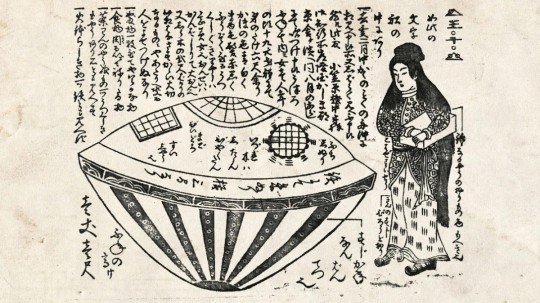
In 1803, a round vessel drifted ashore on the Japanese coast and a beautiful woman emerged, wearing strange clothing and carrying a box. She was unable to communicate with the locals, and her craft was marked with mysterious writing. This story of an utsurobune, or “hollow ship,” in the province of Hitachi (now Ibaraki Prefecture) is found in many records of the Edo period (1603–1868), and Tanaka Kazuo, professor emeritus at Gifu University, has studied the topic for many years. What drew him away from his main research area, applied optics, to investigate this curious episode? And what really took place?
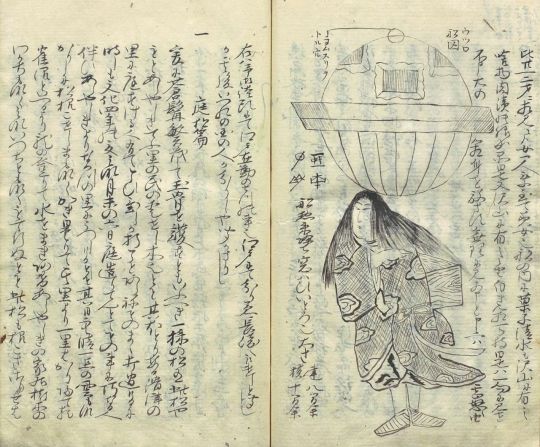
“Like a Flying Saucer”
Tanaka says he began to research the ship after the deadly subway sarin attacks in 1995 by the Aum Shinrikyō cult. “There was a lot of coverage of Aum founder Asahara Shōkō's prophecies and claims to be able to float in the air. Yet the cult’s senior members were part of the scientific elite. I started giving lectures considering paranormal phenomena from a scientific perspective, which meant that I was collecting all kinds of materials for teaching, such as about UFOs in the United States and Japanese folklore. While doing so, I came across the utsurobune legend.” He adds, “Long before the American UFO stories, the craft depicted in Edo-period Japanese documents for some reason looked like a flying saucer. This was fascinating to me.”
UFOs became a modern sensation after the media reported US businessman Kenneth Arnold as having witnessed “flying saucers” on June 24, 1947. A flood of similar stories followed from around the world. Most famously, a UFO was alleged to have crashed to the ground near Roswell, New Mexico, in July 1947. “In the end, though, no wrecks or alien bodies were recovered,” Tanaka says. “There was only the ambiguous testament of witnesses. It was the same with all the other UFO stories from around the world—they were mysteries without any substantial evidence. The utsurobune legend, however, has a number of documents to examine as leads, so in this sense, for researchers it’s a mystery with substance.”
A book published in English by Tanaka Kazuo on his research.
There are similar oral traditions about “hollow ships” across Japan in the Edo period. Tanaka’s research is focused on the various documents that describe the 1803 incident in Hitachi and include illustrations of a beautiful woman and a strange vessel, although they cite different dates. One of the best-known sources is the Toen shōsetsu (Toen Stories), an 1825 collection recording fantastic rumors, which was written by the Toenkai literary circle and edited by Kyokutei Bakin, famous for his lengthy historical romance Nansō Satomi hakkenden (The Eight Dog Chronicles). Others are Nagahashi Matajirō's 1844 work Ume no chiri (Plum Dust), as well as collections like Ōshuku zakki (Ōshuku Notes), Hirokata zuihitsu (Essays by Hirokata), and Hyōryūki-shū (Records of Castaways), which gathers stories of foreign ships washed up in Japan and of Japanese sailors who came ashore overseas.

Picture 1- Hyōryūki-shū (Records of Castaways) by an unknown author. The text describes the woman as being around 18 to 20 years of age, well-dressed, and beautiful. Her face is pale, and her eyebrows and hair are red. It is impossible to communicate with her, so it is unclear where she is from. She holds a plain wooden box as though it is very important to her and keeps her distance. There is mysterious script written in the boat. (Courtesy Iwase Bunko Library in Nishio, Aichi Prefecture)
Pictures 2 and 3- Unknown (maybe Mito bunsho)
Picture 4- From Ōshuku zakki (Ōshuku Notes; around 1815) by Komai Norimura, a vassal of the powerful daimyō Matsudaira Sadanobu. (Courtesy National Diet Library)
Picture 5- From Hirokata zuihitsu (Essays by Hirokata; 1825) by shogunate retainer and calligrapher Yashiro Hirokata, who was also a member of the Toenkai circle. (Courtesy National Archives of Japan)
This post is mostly sourced from nippon.com and japantoday
2K notes
·
View notes
Text
4 Things You Can Try Now That You’ve Read THIS IS HOW YOU LOSE THE TIME WAR
(technically 5 things)
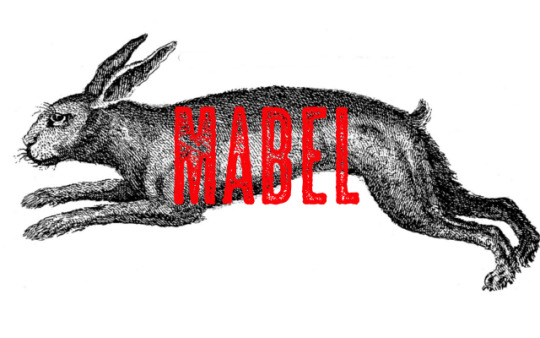
Mabel - a podcast by Becca De La Rosa and Maybell Marten.
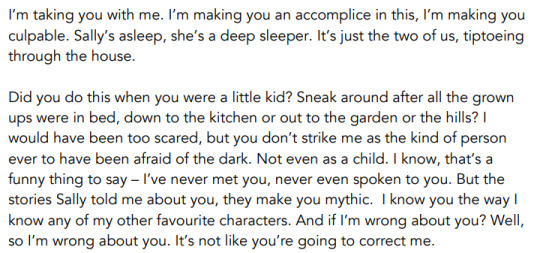
Anna Limón is a home help worker currently looking after the elderly Sally Martin. When Sally has a bizarre and frightening reaction to a box of letters Anna finds in her attic one day, Anna attempts to seek answers by contacting Sally’s only known living relative: Mabel Martin.
“A podcast about ghosts, family secrets, strange houses, and missed connections,” Mabel is a story that is difficult to describe, but one of the most important points is that the vast majority of it is an epistolary narrative between Anna and Mabel, just like how This Is How You Lose The Time War is an epistolary narrative between Red and Blue. It also has a very distinct writing style- dramatic, flowery, and a little bit intimidating. However, if you loved the writing style of TIHYLTTW, I personally think that Mabel is a perfect match for you.

And I’m not just saying that because Mabel is a story about two extremely overdramatic women who are somehow both frighteningly caustic yet almost adorably useless.
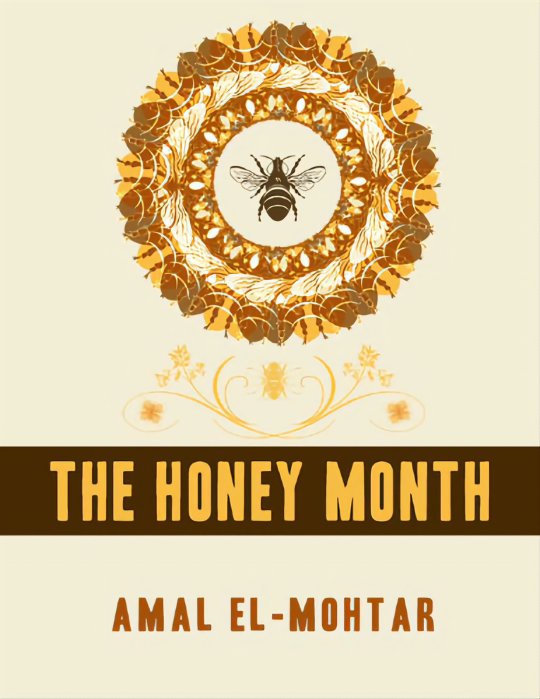
The Honey Month - a book by Amal El-Mohtar
I certainly hope I don’t have to tell you this, but Amal El-Mohtar is one of the authors of This Is How You Lose The Time War, and The Honey Month is a short book she wrote several years ago.

The Honey Month is almost more of an experiment than a book- in its introduction, a friend of El-Mohtar explains how she sent her several small samples of honey, leading El-Mohtar to use the gift as in a unique way. For one February, every day she used a different vial of honey as inspiration for a small piece of writing.
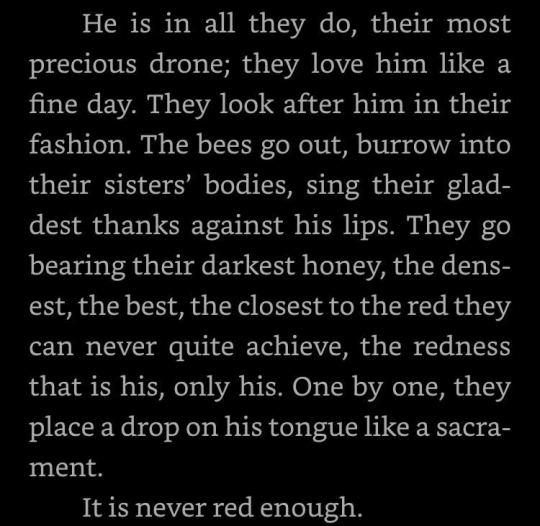
The Honey Month contains 28 short pieces of writing, poetry, prose, and some things in between. It’s a small book full of things with big impact, and contains the lyrical yet meaty writing I enjoyed from El-Mohtar in TIHYLTTW.
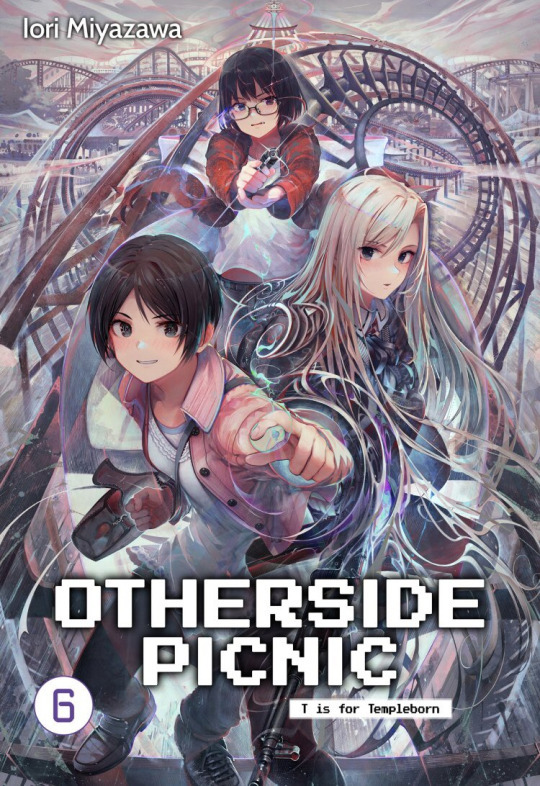
Otherside Picnic (裏世界ピクニック) - A series of novels by Iori Miyazawa (illustrated by Shirakaba)
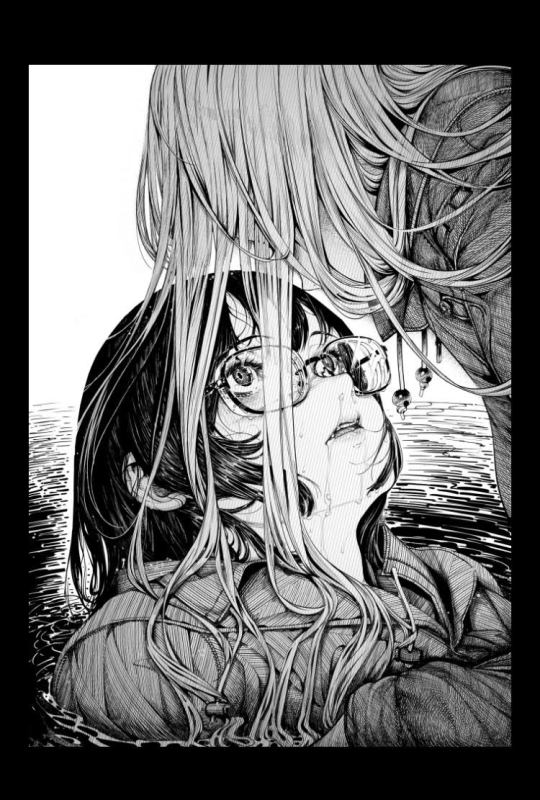
College sophomore Sorawo Kamikoshi longs to find an escape from other people, and in trying to find it discovers the Otherside, a strangely beautiful yet unfathomably dangerous parallel world inhabited by the-once-fictional creatures she knows from net lore. She also meets Toriko Nishina, another young woman with a knowledge of firearms and a desire to find her missing mentor. Together, these two girls explore the Otherside and find themselves changing little by little, both due to their adventures, but also due to their relationship with each other.

If you know me you probably aren’t surprised at this reccomendation. Otherside Picnic is a truly odd beast- it’s sci-fi, it’s horror, it’s comedy, it’s yuri. It’s about trauma, it’s about Japanese creepypasta, it’s about useless lesbians, and it’s about how the scariest thing of all is being vulnerable with another human being. I think fans of This Is How You Lose The Time War will enjoy it- Otherside Picnic’s writing style will likely feel almost spartan compared to TIHYLTTW, but in my opinion there’s a similar level of poetry in it. There’s also a similar level of women who are “badass” yet kind of messes. You’ve heard of “Enemies to Lovers,” get ready for “Accomplices to Lovers”!

(there’s also a manga adaptation by Eita Mizuno, as well as an anime adaptation directed by Takuya Sato)
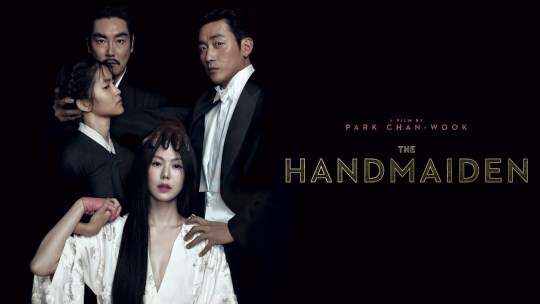
The Handmaiden (아가씨) - a movie directed by Park Chan-wook (written by Park and Chung Seo-kyung, based on the novel Fingersmith by Sarah Waters)

In Japan-occupied Korea, the pickpocket Sook-hee is recruited by a con-man to aide him in his scam of a Japanese heiress, Lady Hideko. While the con-man poses as “Count Fujiwara” and woos Hideko, Sook-hee will play the part of her maid and subtly push the heiress towards him. But as time passes, Sook-hee begins to realize there are things occuring in the mansion that are even more sinister than her and the Count’s scheme, and there is much, much more to Hideko than meets the eye.
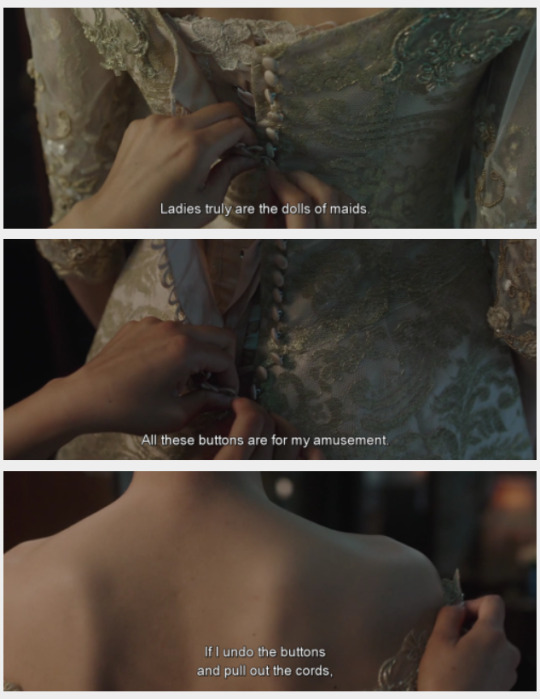
This is a list of recommendations for “people who have finished “This Is How You Lose The Time War,” but I try to recommend The Handmaiden to as many people as I possibly can. I’ve described it in the past as the cinematic equivalent of running a marathon: with a 144 minute runtime full of gorgeous direction and set design, dark machinations, twisted yet romantic writing, often troubling themes, and so, so many plot twists, it’s a movie that nearly feels like too much of a good thing. But for fans of TIHYLTTW, I’m sure what will intrigue you most is the relationship between the two main characters, one so complicated that “Enemies to Lovers” can’t hope to capture the roiling feelings of pity, guilt, hatred, desire, annoyance, sympathy, and everything in between.
It’s also just really hot.
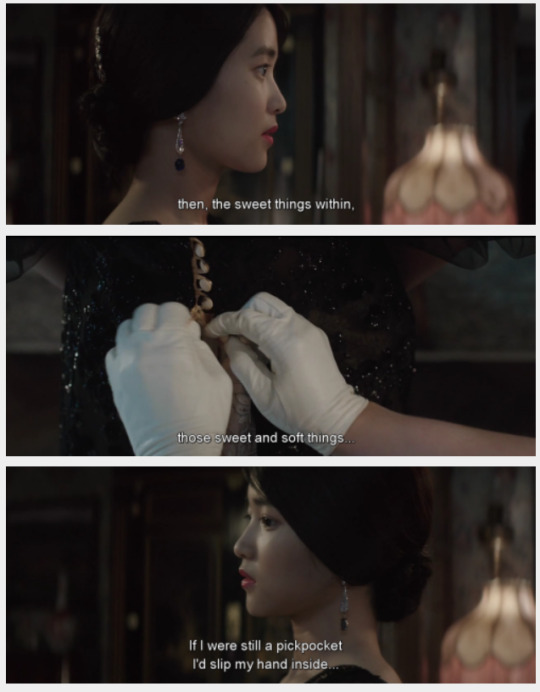
The Handmaiden is a movie that is best enjoyed going in knowing as little as possible. That said, it is also a story with dark and often upsetting themes that are absolutely crucial to its narrative. If you are concerned about that statement, I reccomend looking at the movies’ entry on DoesTheDogDie, which I have looked at and found to be a pretty comprehesive list of content warnings that can be examined in a way that doesn’t spoil the twists of the story.

Fingersmith - a novel by Sarah Waters
I’m sorry, I’m sorry, I swear I’m going to get around to it!! I can’t technically recommend the book that inspired The Handmaiden since I haven’t read it yet, but I have at least one friend whose opinion I trust who sings its praises, so it’s good enough for me. Besides, if the recent popularity of This Is How You Lose The Time War has showed us anything, it’s that people constantly crave stories about complicated women, so it certainly can’t hurt, right?
#this is how you lose the time war#max gladstone#the honey month#amal el mohtar#the handmaiden#fingersmith#mabel#mabel podcast#otherside picnic#tihylttw#trigun#bigolas dickolas wolfwood#yuri#gl#sapphic#wlw#lesbian
604 notes
·
View notes
Text
New gesture Emoji in Unicode 15.1: Head Shaking Horizontally and Head Shaking Vertically (aka shake and nod!), and (finally) right facing emoji
Unicode 15.1 will be rolling out to phones and computers across this year. It will include lots of new CJK (Chinese Japanese Korean) ideographs, some new line-breaking rules for syllabic scripts, and a handfull of new emoji! There's a phoenix, a breaking chain, a lime and a brown mushroom, as well as new family silhouettes and a handful of existing emoji, but now facing rightward!
Below are illustrations of the set from a recent Emojipedia summary of the 15.1 update.
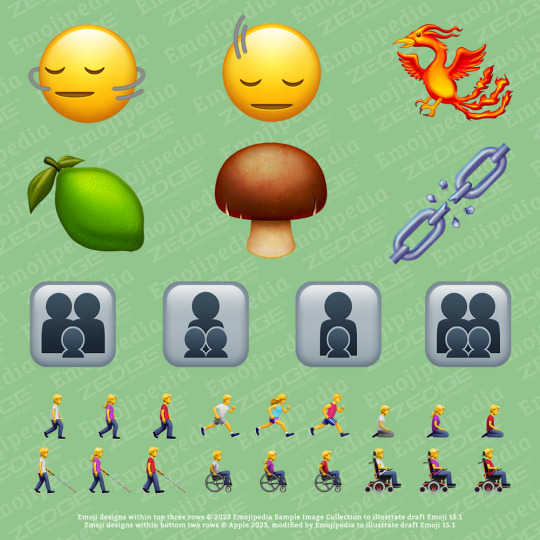
The two emoji I'm most excited about are Head Shaking Horizontally and Head Shaking Vertically. That's head shaking and head nodding to you! I wrote these proposals with Jennifer Daniel and the Unicode emoji subcomittee team.
Why the more elaborate names? Well, Unicode tend to describe emoji by form, not function. That's for very good reason, because a head nod might be agreement for you, but in other cultures a vertical movement of the head can mean disagreement. This has provided a double challenge for emoji designers, who have to both show movement and also facial features that aren't too positive or negative. Below are the Emojipedia pair. They've done a great job.

These two emoji are actually made by combining a classic emoji face wtih the horizontal (🙂↔️) or vertical arrows (🙂↕️ ) using a special Unicode character called a Zero Width Joiner (ZWJ, 'zwidge' to it's friends), which means that even though they're two characters they smoosh together to create one emoji. It's the same process that makes all the different flags, as well as the gender and skin tones.
In fact, all of the emoji in 15.1 are combinations using the ZWJ mechanism; including the phoenix (🐦🔥), lime (🍋🟩) and brown mushroom (🍄🟫 ). Those new right-facing emoji are a combination of the usual left-facing emoji and a rightward arrow🚶➡️ .
It's exciting that Unicode have decided to try this set of right-facing characters. Many emoji are left-facing, which is a legacy of their Japanese origins (the word order in Japan means that right-facing makes sense). I've been complaining about emoji directionality since 2015, and I'm glad that this update will mean that lil emoji dude can finally escape a burning building for those of us with a left-to-right writing system and Subject Verb Object word order. They've started with a bunch of people in motion. It will be interesting to see if this set is where it stops or not.


(no no buddy!! To the exit!!)
The use of the ZWJ is an elegant solution because it means that you don't have to make a whole new codepoint for the emoji, it just uses the old one. If someone doesn't have their phone or computer update to 15.1 then it should fall back to just showing 🚶➡️, which somewhat conveys the intent. That's the magic of a good ZWJ combination.
Earlier posts on emoji gesture
Gesture emoji: contributing to the Unicode standard
New Publication: The Past and Future of Hand Emoji
Gender Variations for Person in Suit Levitating Emoji - Emoji Proposal
New draft emoji include 3 proposals I co-wrote!
Emoji as Digital Gestures in Language@Internet [Open Access]
Earlier posts on emoji directionality
Emoji Deixis: When emoji don’t face the way you want them to
Don’t run towards the fire (the on-going problem with emoji directions)
70 notes
·
View notes
Text
Delving into Pearl and Marina’s relationship
After seeing the new trailer for Splatoon 3’s DLC, Side Order, which seems to focus on Off the Hook, I wanted to make a quick recap of their relationship up until now.
The idol duo Off the Hook consists of its two members, Pearl and Marina. Pearl being the more outgoing inkling rapper of the group and Marina being a clever octoling DJ.

Firstly, their base designs make it clear that they are supposed to be opposites. Marina being tall and having big ears and Pearl being shorter than the average inkling and having small ears, would be one example of this. Another would be their clothing. Whereas Pearl wears a white dress with golden accents, Marina mainly wears black clothing with silver details. Unlike the Squid Sisters, Off the Hook’s idol outfits only match in certain aspects, like their boots and zippers, yet they still look like a cohesive duo despite that. The most prominent opposite would be the fact that Pearl is an inkling and Marina is an octoling, however. Also keep in mind that Marina was one of the first octolings coming to the surface after she heard the Calamari Inkantation.
You first encounter Off the Hook in game during their stage announcements*, where you learn small bits about their personality. Here you see how they mock each other in a playful way, but are still supportive of one another as friends. It also highlights how close they are, as they know a lot about each other and seem to spend a lot of time together.
Though Off the Hook doesn’t play a major role in the base game, they really have a chance to shine in the Octo Expansion DLC. Most of their characterization here is done through chat rooms* that add a lot of personality as well as some more information regarding their relationship. While still joking and mocking each other, they also frequently compliment and show admiration for the other. For instance, when Marina calls Pearl “srsly the coolest” (Session 3), as well as Pearl considering Marina “one of the best people [she knows]” (Session 6). On some occasions, their close bond is even displayed through pictures, like when Pearl shares a photo of Marina napping on a Pearl pillow. But even in more serious moments like when Pearl learns of Marina’s past, she still decides to trust her and even goes as far as to threaten Craig Cuttlefish. Marina is also incredibly grateful to Pearl and thanks her when she assures Marina that she will still be accepted in Inkopolis.
Off the Hooks’ admiration for each other is also clearly displayed in their backstory. Though Pearl probably was the first inkling she encountered on the surface, Marina had a “feeling about [her]” (session 8) and asked her to form a band after only meeting a few times prior on Mount Nantai. She even went as far as to go to the Mountain for a whole week in hopes of seeing Pearl again. Later on, Pearl taught Marina “everything [she] needed to know” (Session 8) and is still extremely thankful to her.
By the time the player reaches the final boss of Octo Expansion, they finally meet Off the Hook in person. Though the player’s time with them is cut short due to the looming battle, their characteristics still shine through. Marina clearly idolizes Pearl, as seen in her drawing during the explanation of the fight. After defeating the NILS statue, Marina immediately rushes to hug Pearl, which clearly indicates how important Pearl is to her.
Furthermore, the Final Splatfest really illustrates their bond well. The new special shifty station “MC. Princess Diaries” or also known as “Dear Senpai” in the Japanese version depicts Marina’s admiration for Pearl again. Senpai describes an upperclassman mentoring an underclassman in Japan. As Pearl taught Marina everything about Inkopolis, she can be considered an upperclassman to Marina. Additionally, Marina is the one responsible for building the shifty station, which in this case is in the image of the Octo Expansions final boss, so we can assume the title reflects her standpoint. Marina clearly has a deep affection towards Pearl and cherishes her. I’d also like to add that the title almost sounds like the beginning of a letter, like Marina having learned everything there is to know and now saying farewell, which might have something to do with Side Order (I might be reading too much into this, though). Perhaps it could also reflect a love letter written for Pearl. In addition, Pearl could also consider Marina an upperclassman to her, as she taught Pearl a lot about music, such as meter and rhythm.
During the Final Splatfests announcement, Marina voices her concerns about Off the Hook breaking apart. Lines such as “Off the Hook means everything to me! It's all I have in this world...” show clearly how grateful she is to have met Pearl. Yet, Pearl also reassures her by stating that Marina has “WAAAY more going for [her] than just Off the Hook.”, displaying Pearl’s trust in her.
After the Final Fest reached its conclusion, the results were announced. Pearl begins by describing the time she has spent with Marina as “the best years of [her] life” which worries Marina, as she believes Off the Hook is going to break up. But to everyone’s relieve, Pearl just wants the duo to break into new genres of music as they “take over the world” together. After promising that they are going to stay together, Pearl reassures Marina, that she loves her, really conveying the close bond they have. This part of the dialogue wouldn’t have changed if Team Order had won, highlighting its importance. Besides, we can still see them making music together with the band Damp Socks in Splatoon 3.
Lastly, I want to talk about some media outside the games. In an Octotune interview with Pearl, she states that meeting Marina is the best gift she has ever received, signaling how she cherishes Marina and how much the time they have spent together means to her. Furthermore, the Splatoon manga includes a short shōjo manga (a type of manga targeted towards teen girls) addressed to Pearl called “Dear Pearl” where Pearl is drawn in a very idolized style, similar to shōjo love interests, as well. The last panel of the manga depicts a love letter addressed to Pearl. In the Japanese version, the manga ends with Marina dreaming about shouting out "these feelings [for Pearl]" through a megaphone. Similarly, the relationship between Pearl and Marina is described as ”Marina, let's make the whole world ours!" - "Yes, Pearl-senpai!” in the official Splatoon 2 character chart. In another official relationship chart, Marina is described as a “maiden in love” with Pearl’s description stating “it is me”, implying Marina has romantic feelings for Pearl.
Whether you ship them or not, you cannot deny that they don’t have a lot of respect and adoration for each other. Their relationship is really sweet, and I can’t wait to see how Side Order will develop it further. Their ink colors really became something special after being mixed together.
Stay fresh and thank you for reading!

“It's you and me against the universe, 'Rina!”
(Also, I tried to keep this as neutral as possible, but those two are definitely in a relationship)
*Here’s some stage announcements as examples:
Port Mackerel:
Pearl : Marina! What's the appeal of using a brella on this stage?
Marina : Protecting my precious Pearlie at all costs!
Wahoo World:
Pearl : Remember when we rode the roller coaster for six hours straight?
Marina : That was nothing compared to the eight hours we spent on the Death Drop!
Pearl : Yo, at night, the Ferris wheel's all... like...sparkly and junk.
Marina : You're so adorable, Pearl.
The Reef:
Pearl : Look at me! I'm Marina! BLAH BLAH BLAH!
Marina : Ahaha! Yeah, that's so me!
Pearl : My best friend took me to this amazing cake shop in The Reef the other day!
Marina : But I don't remember going to a cake shop...
Snapper Canal:
Pearl : I've been here before. A boy from school brought me when I was a kid...
Marina : REALLY?! Was it a date? A battle? Spill it, Pearlie!
Kelp Dome:
Pearl : I bet you looooove all the weird machinery here, don't you, Marina?
Marina : Is it that obvious?!
Pearl : Yo, I'll splat a dude with attitude, I don't carrot all like rabbit food!
Marina : OHHHHHHHHHHHH! Best rapper alive.
New Albacore Hotel:
Pearl : Remember that time you tried to drown me here? Good times.
Marina : For the last time, I was trying to help you get to the floating stage!
Manta Maria:
Pearl : Let's sail across the seas and make our debut in the new world!
Marina : OK, but only if you learn how to at least say hi in another language first.
Pearl : The ocean is breathtaking, yo... I wonder if there are any little fishies around.
Marina : Fishies? Aww! Pearl, you're so cute...
Moray Towers:
Pearl : Hey! How come I always have to talk first when we announce the stages?
Marina : To set up the punch line, of course! How else am I supposed to poke fun at you?
Arowana Mall:
Pearl : The shops here sell different stuff than the ones in The Reef. I love it!
Marina : I know! It's so cool you found a place that carries XXXS-size shirts!
*Some examples from the chat rooms:
Session 3:
MC.Princess > Yo how do I make the chat window full screen?
DJ_Hyperfresh > Alt-F4
■Webmaster■ > MC.Princess has left the chatroom.
DJ_Hyperfresh > Can't believe that actually worked...
DJ_Hyperfresh > Don't tell her I said this, but Pearl is srsly the coolest.
Session 6:
MC.Princess > So you probably can't tell but just between you and me, Marina's kind of a weirdo. She's like freakishly tall and way to smart for her own good
MC.Princess > just the other day she built an entire battle stage all by herself. It had huge floating rocks and everything. Crazy right?
MC.Princess > WHAT. Nah, Marina would never design something like that
CraigCuttlefish > its right there in the file
MC.Princess > now that you mention it, Marina IS totally obsessed with machines. And she's definitely the hardest working person i know
MC.Princess > Right?! She might have some skeletons in her closet, but who doesn't am i right? Marina is one of the best people i know.
CraigCuttlefish > i guess shes okay for an octo
MC.Princess > I swear, cuttlefish. If you try to splat Marina I WILL CUT A FISH. U GOT THAT?
Session 7:
DJ_Hyperfresh > Do you think I'll still be welcome in Inkopolis? Once everyone knows I'm an Octoling?
MC.Princess > ARE YOU KIDDING? Of course you will! everyone loves you!
DJ_Hyperfresh > Thanks, Pearlie. ;__;
Session 8:
DJ_Hyperfresh > That makes sense. You've got a knack for teaching. ♪
DJ_Hyperfresh > Haha, remember when we first met, Pearl? I had just come to the surface, and I didn't understand Inkopolis at all. You taught me everything I needed to know.
DJ_Hyperfresh > I went to Mount Nantai every day for a week, just hoping you would show up again.
MC.Princess > LOL Marina I just remembered you made that entire demo using that half-busted keyboard you had. But somehow the hook was still dope
DJ_Hyperfresh > I was shocked the first time I heard you rap. I thought for sure you were gonna be wack tbh, but once you started spittin I was like, "dang, this munchkin got bars."
DJ_Hyperfresh > Anyway, I know we talk a lot of smack on the show and all, but I just wanted to say thanks. For everything.
Octotune interview:
Q17: What is the best gift you have ever received?
Pearl: The chance to meet Marina.



Sources:
#splatoon#splatoon2#splatoon octo expansion#off the hook#pearlina#pearl houzuki#marina ida#side order
146 notes
·
View notes
Text
Hey all! I waited to announce this until I had the physical tickets in hand. But it's confirmed– this weekend, I will be visiting Cool Japan Park Osaka to watch the Mononoke stageplay!
I scouted out the venue last evening. None of the staff spoke English, so I used the Google Translate app liberally to communicate haha

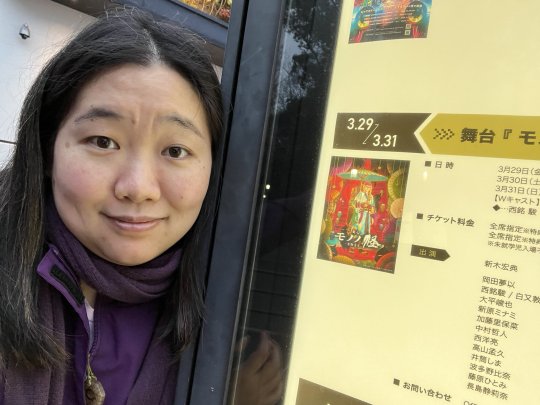
When I attend the showings on Friday and Saturday, I'll be giving away prints of my latest Mononoke illustration. If you happen to be there, please come say hello!
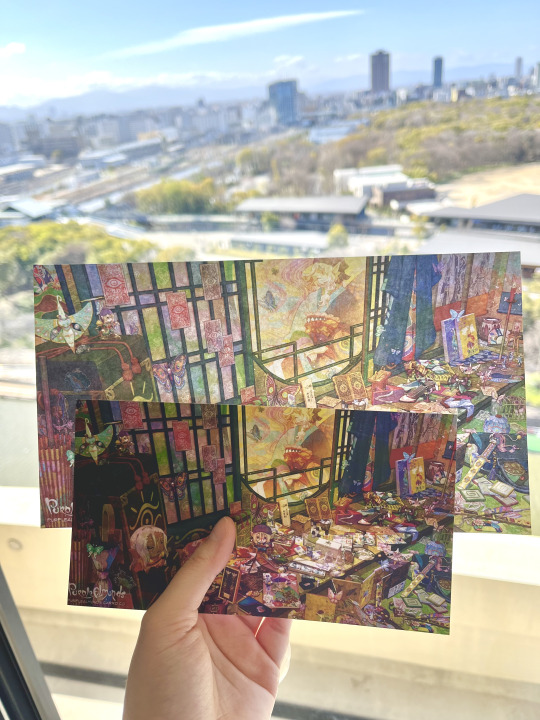
After I watch the play, I'll try to the best of my ability (and my Japanese language barrier) to describe my experience!
35 notes
·
View notes
Text
The many puzzle-pieces that served as inspo for Sukuna
A long time ago I made a little deck about elements of Buddhism woven into Jujutsu Kaisen's story.
Since I got a little time on my hands (and he's finally made it back to the manga!) I'd like to put this little run-down on influences Sukuna draws from here as well and extend a bit on it, since more than 2 years have passed since then. (And I've been meaning to rework the deck, but lack time and wantto get at least this one out properly again).
First of all - I don't think Gege copies any character or legend 1:1. IMO, Gege is drawing from various sources and remixing them into his own thing. Whether that's for the story, setting, characters or specifically Sukuna.
So let's have a look at all the historical and mythological characters Sukuna is remixed from.
Ryoumen Sukuna the 2Chan Urban Legend
This is the one probably the most people have heard about, since Gege openly mentioned having drawn inspiration from this:
The 2Chan post about an urban legend how some construction workers allegedly found a 2 meter sized box labeled as "Ryomen Sukuna" with a mummy of conjoined twins inside. The guys who opened it fell sick. The box was given to a local priest to handle the bad energies and at some later point someone called the priest's son and learned it was some deformed freak who died in a way some Buddhist monks practiced a long time ago - by simply meditating ascetically until you enter mummification while still alive.
You can read more on that here.
This is where Gege was clearly inspired to get mummified Sukuna, full to the brim with negative energy, delivered to the story in a box.
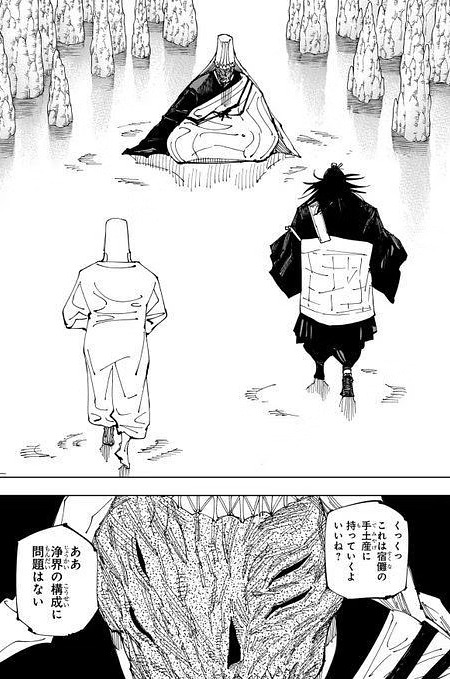
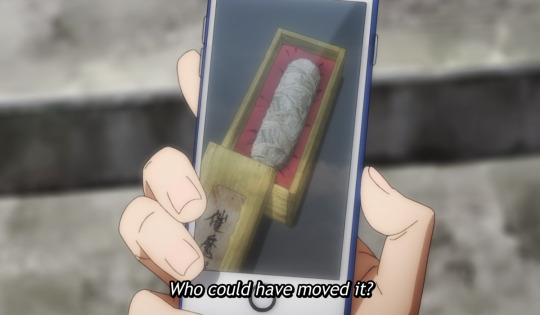
The "Rasetsu" Daijizaiten/Ishanaten (伊舎那)
Rasetsu are demon-spirits that reside in the heavenly realms, who have the power to influence and seduce humans, and then eat them.
In Buddhism rasetsu are also believed to act as wardens under The Lord of Hell - Enma - punishing the damned.
Ishana/Ishanaten/Isana/Daijizaiten is a demon spirit from the highestheaven of the world of desire and is often shown with a three-pronged spear in right hand, and a bowl of blood in his left. He is one of the eight manifestations of Shiva and presides over cosmic destruction.
While he is usually described with many-faces and many arms,
in the Womb World Mandala he appears with two arms, dark
red in colour, seated on a dark-blue buffalo, and accompanied
by his consort "Uma"(烏摩), also seated on a buffalo.
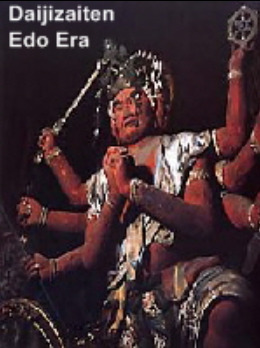
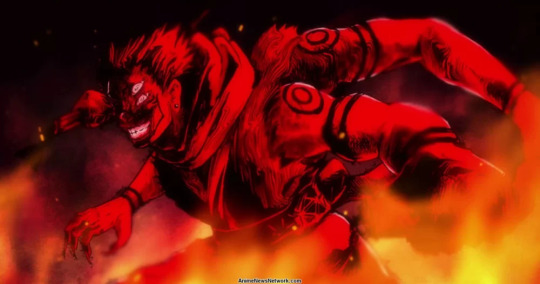

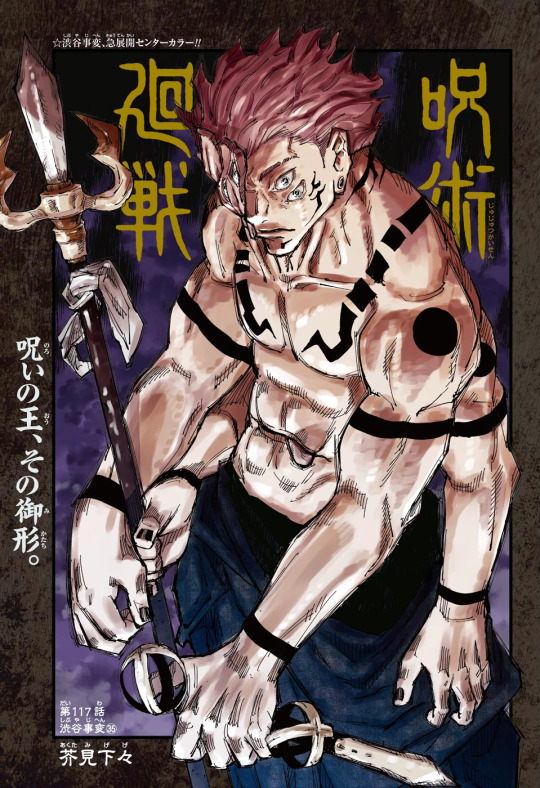
I believe this is what inspired the design for Sukuna's original giant curse form. Color-coded in red, eating humans, holding a three-pronged spear and drinking blood while causing destruction. Yup. Sounds about right.
Daijizaiten's son, Kitchen God Sukanda/Idaten
Daijizaiten has a son, Idaten, also called Sukanda 塞建駄, who
is the God of the Kitchen and looks after the provisions of the
Buddhist brotherhood.
He is known as a swift runner, because legend has it that he ran with great speed to catch a demon thief who stole the
ashes of the deceased Buddha. Wherever there is trouble, he
is instantly found there. His appearance is not described. In
Japan he is usually in a little shrine attached to the monks' dining-room
I believe this is where Gege got the inspiration to give Sukuna his little cooking theme he got going on around his curse technique and domain. From the Japanese name for the shrine that can be read as an imperial palace's cooking quarter, through his cleave & dismantle technique that is illustrated with respective sushi knives for skinning and chopping fish. And of course he is cooking with fire, as we see with Jogo.
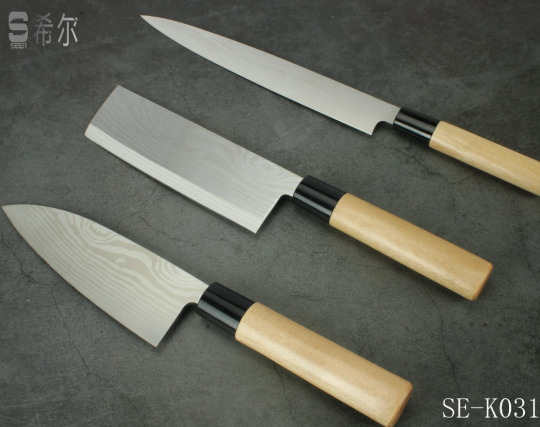
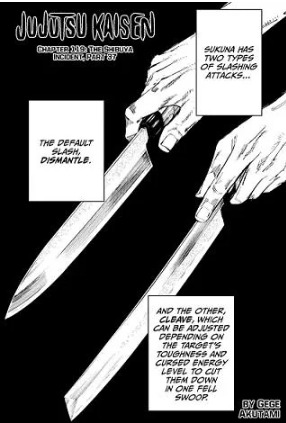
Interesting that Sukuna has all this sushi chef imagery going on, when there is so much fish symbolism in the story and especially the anime - from the culling games' original name Japanese name referring to the annual fish migration to all the fish shown in the Season 1 intro and a lot more.
Of course, there is also the little shoutout to this when Sukuna tells Gojo he's nothing but a fish on his chopping board.

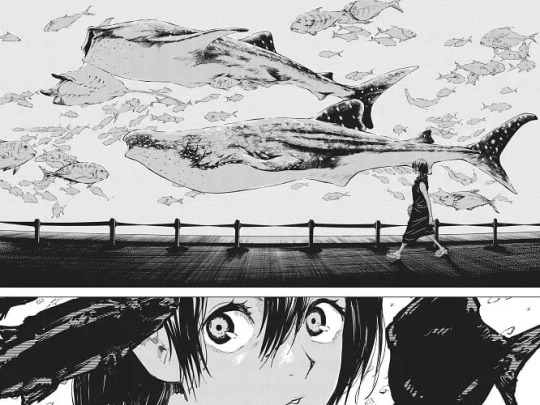


Heian era scholar & poet Sugawara no Michizane, deified after death
Sugawara no Michizane was a respected politician and poet at the imperial court for most of his life.
Michizane took a great liking to plum ("ume") trees. In his later years, there was a power struggle between rivaling clans and after the emperor he worked under abdicated, he was demoted, banished and sent into exile by the new (Fujiwara) clan who assumed all influential official posts and rose to power.
Exiled, he wrote a famous haiku bemoaning the absence of his favourite ume tree.

(It does fit awfully well to Uraume not forgetting Sukuna for a thousand years until they reunite, huh?)
According to legend, his favorite plum tree flew from Kyoto to Dazaifu in Kyushu to be with him.
Shortly after, he died in exile.
Now something very peculiar happened - shortly after Michizane died, the land was struck by death, plague and drought. The new emperor's sons all died one after the other. Lightning repeatedly struck the Imperial Palace's Great Audience Hall and there were rainstorms and floods for weeks.

People assumed Michizane had become a vengeful spirit and built a shrine (Kitano Tenmangu) to appease him, while posthumously restoring his office and titles and planting many ume trees.
Legend also states that during Michizane's funeral procession, the bull pulling the cart bearing his remains refused to go any further than a certain spot, so his shrines are usually decorated with statues of bulls.
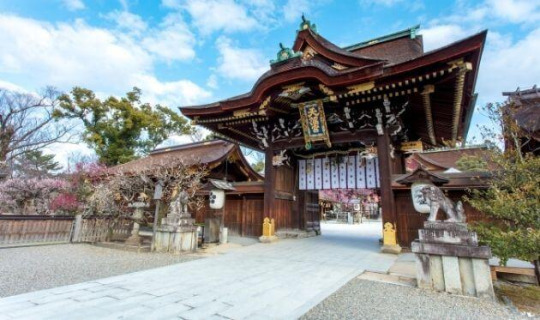
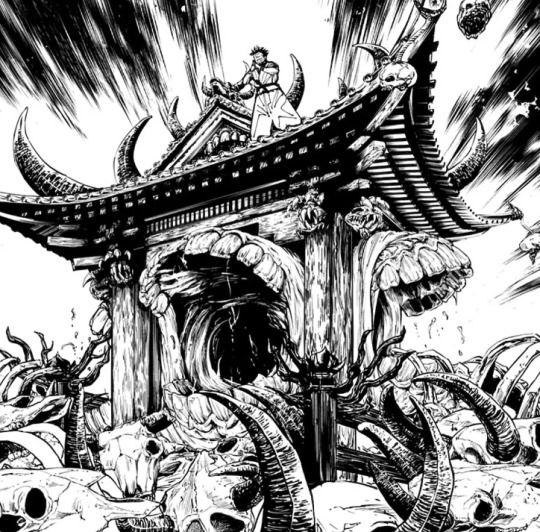
If you look at it, it's really on the nose, isn`t it? :)
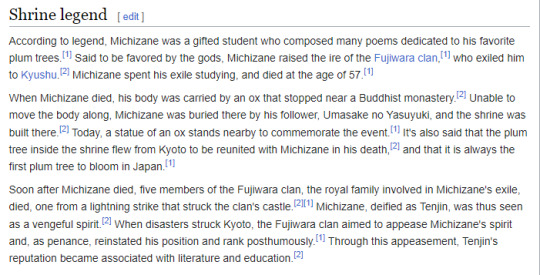
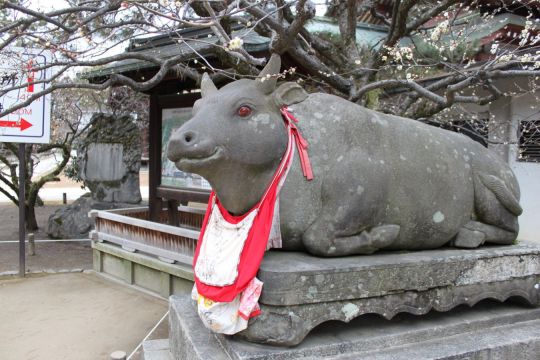
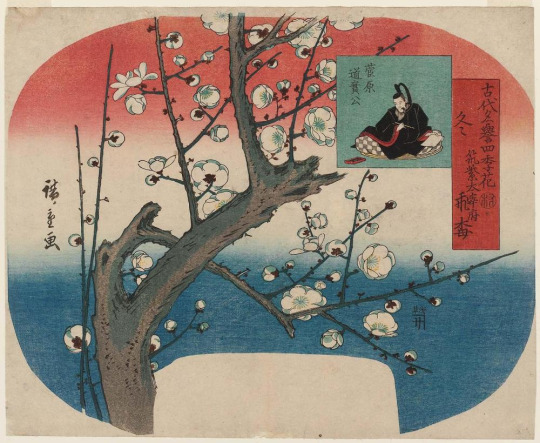
While a few people have been theorizing Sukuna might have known Sugawara no Michizane or that he might be his relative, mostly because Gojo namedrops him as a potential shared ancestor between Gojo and Yuta ... I personally think that Sukuna is partially based on him and I'd love to find out if this is going to have relevance at a later point in the story.
We know so little about Sukuna's time as a human, but when you look at the design of his Malevolent Shrine full of ox skulls, the fact his consort is called Uraume and has plum-themed hair and how he refers to himself as a calamity back in the day, much like plagues, famines & storms, the puzzle pieces really fit together quite smoothly.
And as a last puzzle piece: After a life of being revered and looked up to as a court official next to the emperor, Michizane was exiled and fell from grace at the imperial court when another clan took over —- now remember how Sukuna calls himself ��the disgraced (or „fallen“) one“. How intriguing, is ‚t it?
As for his tattoos:
Inspiration might have been an old Japanese practice to tattoo criminals with symbols indicating their crimes. The practice comes from the Edo times (1603–1867), making it multiple hundred years too late for a Heian (794 to 1185) criminal. Nevertheless, fair game for loose inspiration.
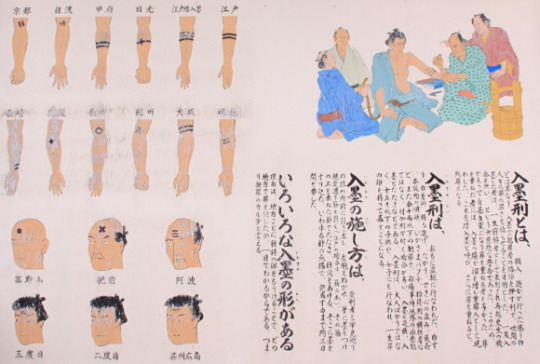
Another inspiration might have been something from a specific Buddhist hell (there are multiples ones).
In Kokujou Jigoku (黒縄地獄), the Hell of Black Threads, those who have killed and committed theft, receive marking lines made of black thread on their body from demons and ogres, so these demons know where to hack their bodies apart as punishment, using axes and saws.

What I find intriguing most about Sukuna's tattoos is that he has them on all his bodies - both Yuji's and Megumi's --- which would indicate they are more like, uh, tattooed onto his soul than his own skin, why else would they show up on multiple meatsuits of his?
My last guess about the tattoos has no footing anywhere, so take it as a random sidenote - I'm just wondering if he might be sealing something with those sigils. Who knows what their purpose is.
Maybe he just likes the look of it, who knows.
So, to recap.
I think Sukuna's appearance in modern times is taken from the 2chan thread as Gege said, his further character design is mostly lent from the Sugawara no Michizane legends (fall from grace, calamities, shrine, ox and "Ume" plum tree included) and his curse form is further inspired by Daijizaiten, the human-eating god of destruction who is also accompanied by an ox and a consort called "Uma" and finished off with a touch of that god's son Sukanda who is a literal kitchen god and a fast runner, tending to a shrine's kitchen.
OF COURSE this man is a scholar turned rogue fun-loving cannibal. <3
His demeanor is not that of a peasant who never learned to read who's struggling to meet ends during a famine, but shows he has been moving among higher ranks back as a human.
He attended festivals as a curse/deity and even cares about the seasonal aspect of Yorozu's haiku.
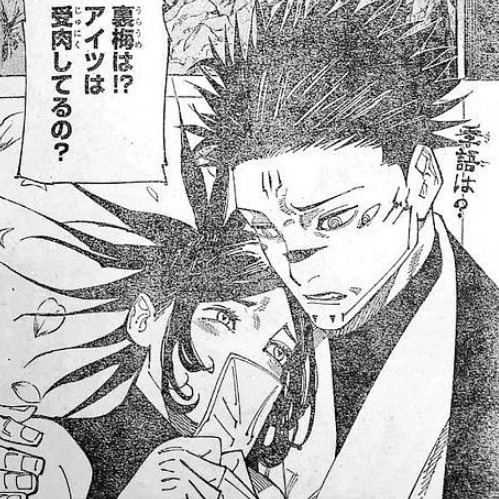
This man has been around the imperial court in the Heian times, knows how to play politics and intrigue and evidently studied mind and soul of humans since way back then, until he rose above it. That's not up for debate, hahaha.
Where his arc is going? We shall see. Still hard to say at this point. You'll find me over here, holding out for a flashback to his past.
Thanks for reading, I hope you enjoyed!
-Jisa
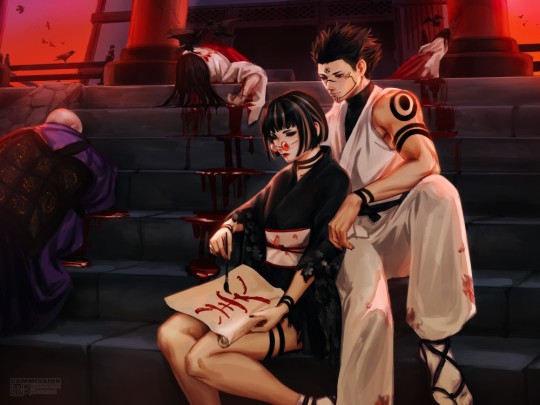
Yup, that‘s me writing poetry in blood with my scholar turned curse upon humanity commissioned from JinRozenrot .
As my old friend Mr Lecter would say: Tada~ ♥
#jjk thoughts#jjk#jjk theory#jjk brainrot#sukuna#ryoumen sukuna#ryomen sukuna#sukuna ryomen#sukuna ryoumen#japanese culture#japanese mythology#buddhism#sugawara no michizane#Michizane Sugawara#vengeful spirit#cursed object#king of curses#jujutsu kaisen
79 notes
·
View notes
Text
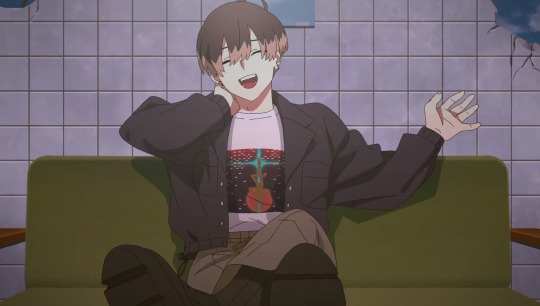
Mikoto Kayano as a Character Design.🧵
This is just one of many parts of my comprehensive analysis of Mikoto Kayano.
Mikoto Kayano is what I would call a high-concept character. What does high-concept mean?
✦ High-concept works tend to be attention-grabbing and appeal to a broad audience, often because they can be easily understood and appreciated on a surface level.
✦ The idea behind the character design may be simple or generic on the surface, but upon closer examination, it reveals intricate details and nuances that add to its complexity and depth. This can make the character design stand out and be memorable to audiences, even if the character's appearance is initially unremarkable or conventional.
Examples of high-concept: (For the inexperienced)
✦ In terms of illustration, Composition (Golden Ratio, Rule of Thirds, etc.) is like a puzzle that the artist puts together, with each piece adding to the overall picture. The main focus is usually in the center of the image or off-center to create visual interest, and other elements are arranged around it in a way that enhances the story being told to reward the inquisitive.
✦ In video games, Platinum’s Hideki Kamiya (Bayonetta, Devil May Cry, etc.) is known for this exact concept. You can finish the game by just casually engaging with mechanics, but if you look deeper into the systems, you are able to execute flawless stylish moves that are very rewarding to execute.
Whenever designing characters, Japan tends to place a strong emphasis on the following:
✦ Name Symbolism - The names are usually a great clue to what a character is about. This includes potential wordplay.
✦ Blood Type - Determines the type of personality they have and their chemistry with the rest of the cast. Think of it as the equivalent of Zodiac signs.
✦Mikoto Kayano Name Breakdown
✦ Kanji - 【榧野 尊】
✦ Katakana - 【カヤノ ミコト】
✦ To get the definitions for the kanji used in this document, I used Goo and Jisho.

【榧】Kaya
✦ Japanese nutmeg tree (Torreya Nucifera)
✦ Flowers bloom around April, and elliptical fruits are produced in the following autumn. The fruit is used for edible oil and hair oil, as well as for food. The wood is hard and used for construction materials, furniture, Go and Shogi boards, and as a carving material.
✦ The flower language for Kaya is “effort”
✦ In Go, the concept of "building a house" refers to creating a territory on the board by enclosing a certain area with your stones. This can be seen as analogous to building a house, where you create a defined space for yourself to live in. The process of building a territory requires strategic thinking, and players must balance offensive and defensive moves to secure the most advantageous positions on the board.
✦ In Shogi, there is a similar concept called "castle." Where certain pieces are used to create a fortress-like structure around the king, making it difficult for the opponent to attack and capture it.
‼️ I feel like anyone with DID/OSDD understands what it feels like. I hope this could be a good allegory for you to use? Although I have shown this example to people with systems, feel free to leave your own thoughts too.
"Kaya no soto" (茅の外) is a Japanese idiom that literally translates to "outside the fence made of kaya grass". The phrase is used to describe someone who is uninformed or ignorant of a situation, or who is excluded from a group or organization.
The kaya grass referred to in the idiom is a type of sedge grass that grows in Japan and other parts of Asia. Historically, it was used to make fences and walls, and was seen as a symbol of exclusion or separation.
The idiom "kaya no soto" is often used in situations where someone is unaware of important information or events, or is not involved in a particular group or community. It can also be used in a humorous or self-deprecating way to indicate one's own ignorance or exclusion.

【野】 No
✦ Field or plain. "野営 (yaei)" means camping, and "原野 (genya)" means wilderness.
✦Field, cultivated land. "野菜 (yasai)" means vegetables, and "田野 (denya)" means rice field.
✦ Folk, civilian. "野党 (yato)" means opposition party, and "在野 (zaiya)" means out of office. [Antonym] Morning.
✦ Natural, wild. "野生 (yasei)" means wild, and "野鳥 (yachou)" means wild birds.
✦ Rough, uncivilized. "野蛮 (yaban)" means barbaric, and "粗野 (soya)" means uncivilized.
✦ Ambitious, exceeding one's status. "野心 (yashin)" means ambition, and "野望 (yabou)" means aspiration.
✦ Classified area. "視野 (shiya)" means field of vision, and "分野 (bunya)" means field of study.
✦ Abbreviation of "下野の国 (Shimotsuke no Kuni)". "野州 (Yashuu)" means Shimotsuke Province. 【Kanji 2】Sho Countryside villa, summer house.
✦ The kanji 【野】 means "field" or "wilderness" in Japanese. It can also refer to "rough" or "uncivilized" behavior or nature. In some cases, it is used to indicate that a plant or animal is in its natural, wild state. It can be combined with other kanji to create words such as 野菜 (yasai) meaning "vegetables," 野生 (yasei) meaning "wild" or "untamed," and 野球 (yakyuu) meaning "baseball."
✦ Added to nouns representing people to express contempt for their uncivilized behavior. "野幇間 (daiko)" means wild street performer, and "野育ち (no sodachi)" means someone who grew up in a rough or uncivilized environment.
✦ It can also be used to combine with words like spacious farm or field to create an expression. "朝早くから野に出て働く (asa hayaku kara no ni dete hataraku)" means going out to work in the fields early in the morning.


✦【尊】Son (Wu) (Han) [Kun] Tattoui, Toutoi, Tattobu, Toutobu, Mikoto
✦ High value or rank; noble. "尊厳" (dignity), "尊属" (noble family), "尊大" (majestic), "尊卑" (social status), "独尊" (supremacy).
✦ To respect and cherish. "尊敬" (respect), "尊崇" (reverence), "尊重" (esteem), "追尊" (posthumous honor), "自尊心" (self-esteem).
✦ A word expressing respect for the other person's matters. "尊翰" (esteemed writing), "尊顔" (honorable face), "尊兄" (esteemed elder brother), "尊体" (respected body), "尊父" (honorable father), "尊慮" (thoughtful consideration).
✦ A word used to express reverence for Buddha or noble people. "三尊" (three pure ones), "至尊" (supreme honor), "釈尊" (Shakyamuni Buddha), "世尊" (World Honored One), "本尊" (principal image of worship).
✦ One very interesting to note is Mikoto’s name and its association with deities. To be specific, the Three Pure Ones. They are often portrayed as elderly deities robed in the three basic colors from which all colors originated: Red, Blue and Yellow (or Green) depending on personal interpretation of color origins by additive or subtractive means.
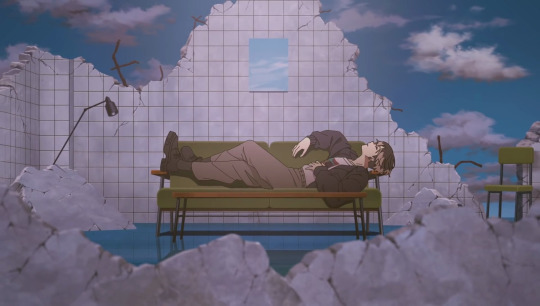
✦ The impression Mikoto’s name gives is, “Someone who has a strong sense of hard work and dedication.”
But here are also possible interpretations of his name:
✦ Noble of the Torreya Fields.
In this interpretation, the name can be seen as suggesting a person who is noble and respected in the fields where Torreya trees grow.
✦ Revered One from the Kaya Field
In this interpretation, the name emphasizes the noble or revered status of the individual who comes from a place where Kaya trees grow (Kaya Fields).
✦ Honorable Torreya Tree Guardian
If we consider 尊 (Mikoto) as representing honor and reverence, it could be interpreted as someone who is an honorable guardian or protector of the Torreya trees or the fields they grow in.
✦ Divine of the Torreya Fields
In this interpretation, Mikoto as "divine" signifies someone who possesses divine or sacred qualities, and is connected to the fields where Torreya trees grow.
✦ Divine One from the Kaya Fields
This interpretation suggests a person with sacred attributes originating from the Kaya fields.
✦ Divine Torreya Tree Guardian
The name could be interpreted as someone who is a divine or sacred guardian or protector of the Torreya trees or the fields they grow in.
✦ A lot of Mikoto's name meanings is about PROTECTION.
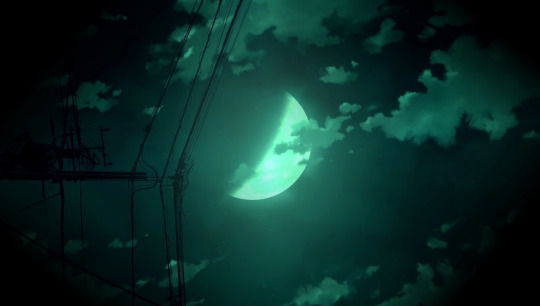

Goroawase (ごあわらせ) is a Japanese wordplay technique that uses the first kana character of each word to create a new word or phrase. For Mikoto’s name (カヤノ ミコト) these would be the meaning:
✦ カミ (KAMI): "kami" (神) can mean "god" or "deity."
✦ ヤミ (YAMI): "Yami" (闇) means "darkness" or "shadow."
✦ ヤコ (YAKO): "Yako" (夜光) means "night light" or "luminescence."
Mikoto also has symbols that connect him to the Polaris Binary Star (if I am remembering this correctly). Let me show you a visual about Mikoto as a character.
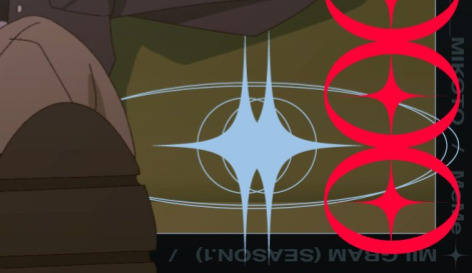

✦Mikoto Kayano's Blood Type: AB

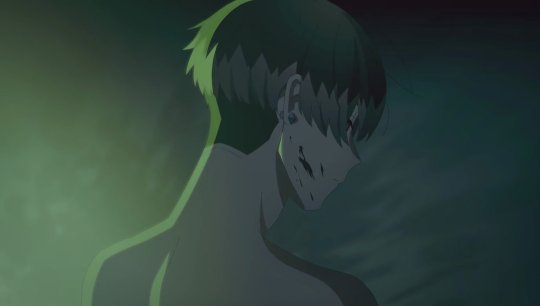
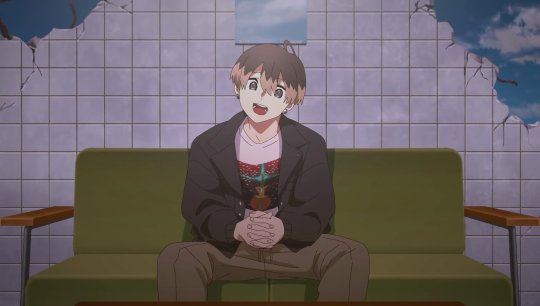

Mikoto Kayano's is Blood Type AB. The only one. It already represents him as an outcast and someone highly unique.
In Japan, the concept of blood type personality theory, known as ketsueki-gata, has gained significant popularity since its introduction in the 1920s. Although the theory has no scientific basis, many people in Japan believe that an individual's blood type can determine their personality traits, temperament, compatibility with others, and even influence their career and romantic prospects. The idea is not dissimilar to the way some people in Western cultures view astrological signs.
Blood type AB is one of the four primary blood types in the ABO blood group system, along with A, B, and O. According to Japanese beliefs, people with blood type AB possess unique characteristics due to the combination of both type A and type B antigens. These traits can be both positive and negative, and individuals with this blood type are often perceived as:
✦ Creative and artistic: Type AB individuals are thought to be highly imaginative, innovative, and capable of thinking outside the box. They may excel in fields that require original ideas and creative problem-solving.
✦ Rational and analytical: People with blood type AB are often seen as intellectually curious, possessing strong analytical abilities and a keen interest in understanding complex subjects.
✦ Calm and composed: Type AB individuals are believed to maintain a sense of emotional balance and are not easily swayed by external events or circumstances.
✦ Ambiguous or mysterious: Due to the mix of traits from both type A and type B blood groups, individuals with blood type AB may be seen as enigmatic and difficult to predict.
✦ Diplomatic and adaptable: As type AB individuals carry characteristics of both A and B blood types, they are thought to be adept at navigating social situations and building bridges between conflicting perspectives.
✦ Aloof and detached: On the negative side, people with blood type AB might be perceived as emotionally distant or reserved, which could make it challenging for them to form close relationships.
✦ Indecisive and disorganized: The blending of type A and type B traits may lead to difficulty in making decisions, a lack of focus, or trouble maintaining an organized lifestyle.
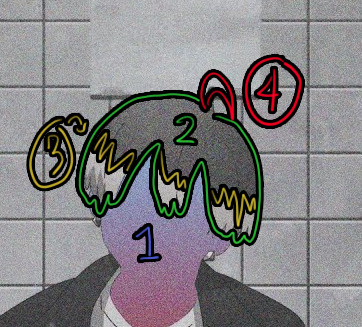
✦Mikoto's Character Design and DID
Mikoto is often described as someone who is "Mass produced" and an "Everyday Man."
But despite this, Mikoto's hair is a great way to describe his complexity. Based on what we know, here's how I would break it down.
You must be wondering why the Ahoge is seen as a separate identity. With character design, they are considered as a character by themselves. When you register them for ownership, the Ahoge or "Character Mark" would be the one registered. The rest is considered generic.
This is Mikoto in a nutshell. Try removing the ahoge, he is almost unrecognizable.
In short, this is genius character design. More explanation about the RGBY colors later on.
✦ We will end this analysis here for now. Please look forward for the next part!
#milgram#milgramtranslations#milgram analysis#milgramtheory#milgram theory#milgram translation#kayano mikoto#mikoto kayano
99 notes
·
View notes
Text
OC questionnaire with alex and winona


alex:
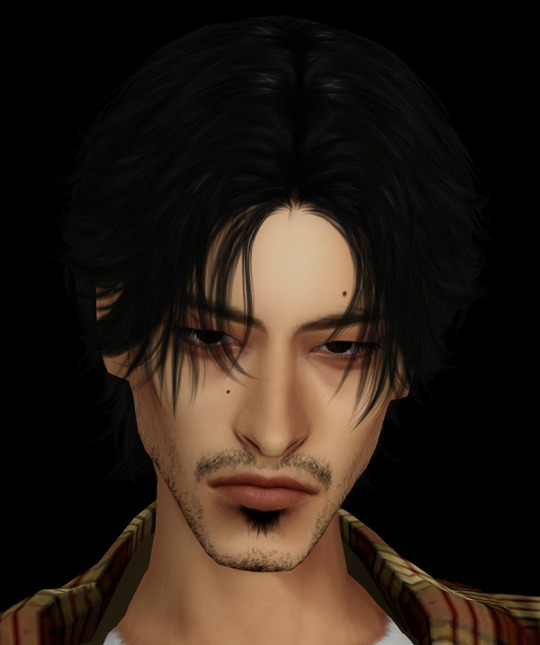
NAME: alexander yamagoe
NICKNAME: alex
GENDER: cis man
STAR SIGN: leo sun, cancer moon, scorpio rising
HEIGHT: 6'8/203.2 cm
SEXUAL ORIENTATION: heterosexual demiromantic (demiromantic is just a term i found on google that best describes it on the aromantic spectrum.. alex considers himself romance averse to everyone who isnt his wife)
NATIONALITY/ETHNICITY: united states citizen, japanese ethnicity (though he has dual citizenship to the us and japan)
FAVORITE FRUIT: depends on which is in season. it's pineapple in summer clementines/oranges in winter. he also LOVES melon (cantaloupe and honeydew)
FAVORITE SEASON: winter
FAVORITE FLOWER: he prefers plants
FAVORITE SCENT: cinnamon
COFFEE, TEA, OR HOT CHOCOLATE: tea but he'll drink all three
AVERAGE HOURS OF SLEEP: zero, two if he's lucky
DOGS OR CATS: cats. he's never had a dog. he likes them, but he much prefers cats
DREAM TRIP: arles and auvers-sur-oise, france (basically everwhere in france that vincent van gogh lived LOL)
NUMBER OF BLANKETS: one comforter one flat sheet (he's very particular about sleeping temperature)
RANDOM FACT: his prized possession is his 1969 original pressing abbey road vinyl
winona:

NAME: winona jessica (saracino) yamagoe
NICKNAME: jessica (alex calls her by her middle name because he thinks it's funny)
GENDER: cis woman
STAR SIGN: sagittarius sun, pisces moon, aquarius rising
HEIGHT: 6'1/185 cm
SEXUAL ORIENTATION: heterosexual and heteroromantic (so boring i know)
NATIONALITY/ETHNICITY: united states citizen, 50% native american, 25% chinese and 25% indian
FAVORITE FRUIT: fresh ripe peach, blueberries, and grapes
FAVORITE SEASON: autumn
FAVORITE FLOWER: she HATES flowers (she's an artist and she thinks depictions of flowers in art is corny so she has taken a stand against all flowers)
FAVORITE SCENT: she loves woody scents.. sandalwood or cedar
COFFEE, TEA, OR HOT CHOCOLATE: coffee but she had to quit so now she prefers tea
AVERAGE HOURS OF SLEEP: six to eight
DOGS OR CATS: cats. she never had pets growing up, so the cats her and alex have now are her first ever pets and she loves how independent they can be but also how funny and entertaining they are
DREAM TRIP: harajuku, tokyo
NUMBER OF BLANKETS: one comforter one flat sheet
RANDOM FACT: art is her entire life. she's an artist by profession, (medical illustrator) but she considers herself an oil painter mostly. she also loves photography, poetry, and bookbinding (she's been writing a lot of poetry lately)
thank you so much @afrolatinotrait for tagging me!!
i'll tag @elksun, @autumnserenade, @superblueisms and @theosconfessions (sorry i wanted to tag more people but i didnt see an oc tag on some people's pages so i didnt want to assume. anybody who has an oc and wants to can do this!!)
#it's so funny that my ocs are both cis and straight when i definitely am not#ocs#mysims#show us your sims#ts4#sims 4 screenshots#thesims#the sims 4#sims 4#the sims#simblr#ts4 simblr#oc:alex#oc:winona
15 notes
·
View notes
Text
‘Godzilla Minus One’: Finding paradise of shared co-operation through environmental disaster
by Chris Corker, PhD Student in the Humanities at York University, Canada
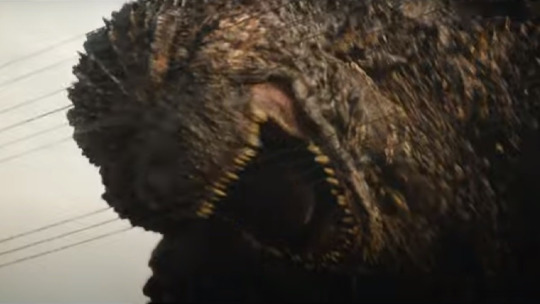
Godzilla Minus One, directed by Takashi Yamazaki, brings viewers back to post-war Japan and to the wholly belligerent monster of the original 1954 Godzilla — a beast bereft of the friendly connotations accrued in the later Toho Studios Japanese installments.
This original Godzilla represented what its director, Ishiro Honda, described as the “invisible fear” of the nuclear contamination of our planet.
Historian William Tsutsui asserts in his book dedicated to the series that the film allows us to neutralize our fears of potential annihilation. Cathartic or not, this apocalyptic trend remains a staple of science-fiction movies and series to this day.
Minus One returns to that fear, once perhaps invisible but now undeniable, of the disasters incurred by damage to our environment.
At the same time, the film asks how individuals and communities can tackle disaster while embracing an ethos of mutual aid that sidesteps nostalgia for nationalist policies that lead to even more harm.
youtube
Disaster response
In the two most recent instalments in the Godzilla franchise, 2016’s Shin Godzilla and 2023’s Godzilla Minus One, the monster can be read as a personification of a diminished belief in governmental abilities to prevent or respond adequately to disaster.
Shin Godzilla, directed by Hideaki Anno, dealt satirically with the limp governmental response to the 2011 Tohoku Earthquake and Tsunami. As the threat of the monster escalates to catastrophic levels, the politicians in the film are more concerned with optics and in which board room they should be conducting their meetings.
youtube
n contrast, 2023’s Minus One captures ire for a nationalistic government that guided Japan into imperial campaigns in Asia and finally to a total defeat with a devastating human cost.
When Godzilla arrives to further compound post-war misery, harried survivors don’t rely on the same government that has led them astray.
Putting aside ideological differences
Instead, as some reviews of the film have noted, they turn to a community with the power to act outside of official bodies, making use of technological skills earned through wartime experience.
While the state lends them a few ships, citizens are otherwise left to their own devices, relying on old and decommissioned machinery. They rise to face the monster not by developing a new weapon of destruction but by using what is already at hand.

ience. As engineer Noda notes, their lives have been undervalued. This realization leads them to turn away from the government and the nationalist policies that led to the war, and to rely instead on one another.
To do this they must put aside ideological differences to achieve the common goal of stopping Godzilla. This is best illustrated by the co-operation of Koichi Shikishima, a kamikaze pilot who questions the value of his death amid imminent defeat yet is dogged by the shame of his desertion, and an engineer, Sosaku Tachibana, who initially deems Shikishima a coward.
Revisiting values, alliances
These plotlines reflect contemporary interest in the local and political communities we should be forging in light of serious environmental threats.
Writer Rebecca Solnit laments self-serving governmental responses to disaster. But her A Paradise Built in Hell focuses on the positives that can come from disaster at the communal level.
She concludes that in enhancing social cohesion and bringing out the humanitarian in each of us, disaster “reveals what else the world could be like.” In short, a paradise of shared purpose and co-operation.
The key, however, is distinguishing between a benign social cohesion, like the aforementioned networks of mutual care, and a malignant one, as seen in destructive forms of nationalism and war.

In Godzilla Minus One, Shikishima and Tachibana band together to save lives. Their wider group insists on a victory without the sacrifice of human life, an ethos made possible by adopting a communal view in which humans are not statistics.
Dream together or die alone
At a time of an increasingly nationalist Japanese government that has been criticized for undermining freedom of the press, the film suggests how a nostalgic dream for a return to a time of stronger social ties and a sense of unified purpose is one easily manipulated by nationalist governments.
This has been seen in a host of recent examples including Donald Trump, Brexit and, as mentioned above, the policies of Shinzo Abe’s Liberal Democratic Party.
On the global scale, the rise of populism, diplomatic spats and outright conflict sees much of the world drawing away from their neighbours. This is happening when, to counteract the effects of climate change and face the exponential increase in disaster, we must unite.
Godzilla Minus One shows how we must rely on a fondness — even a nostalgia — for times of togetherness that do not mix with a nationalist sentiment that encourages isolationism and aggression towards others.
To do so really would be to go from zero to minus one. From there, there is little guarantee we can recover.
#movies#godzilla#kaiju#godzilla minus one#science fiction and fantasy#Japan#japanese film#featured#Youtube
12 notes
·
View notes
Text
Xu Haofeng's first novel was published the following year, in 2007 : "A Taoist Monk Comes Down from His Mountain" ( 《道士下山》 ) . We then spoke of the “hard current” of the wuxia novel (硬派武侠小说) . The story is, however, full of humor: at the beginning of the Republic, a little Taoist monk who can no longer bear solitude comes down secretly from his mountain and returns to the world. Result: he finds himself in a country in chaos, and

“A Taoist monk comes down from his mountain” ( 《道士下山》)
has a series of strange, fantastic encounters that transform his existence.
It is a novel with multiple characters constructed a bit like “At the Water's Edge” ( 《水浒传》) which is the implicit reference . The book was a bestseller.
In October 2008 , the publication of his third novel, “The National School of Guoshu ” ( 《国术馆》 ) [6] , met with the same success: it was placed in the list of the ten best sellers of the year and was even praised by Mo Yan (莫言) . Xu Haofeng asserts his style there.
Unlike Jin Yong or Gu Long, who describe the tricks found by their martial arts masters to win their fights, Xu Haofeng focuses on depicting the way in which his characters comply with very strict training. On the other hand, what is interesting about him is that he often diverges from his narrative line to insert reflections on subjects like calligraphy, painting, food, or antiques, which give depth and diversity to the story. his stories. But above all the story is treated in the style of fantastic realism (魔幻写实主义) that Xu Haofeng knows well: he wrote an essay on Borgès, “The Eye of Borgès” ( 《博尔赫斯的眼睛》).
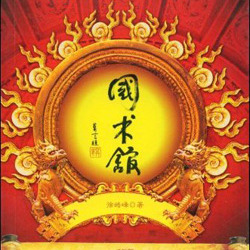
“The National Kung Fu School” ( 《国术馆》)
The main character is a young man who believes he was director of the school of the title in Nanking in the 1920s. He is described with great humor, continuing to apply rules from another age, like a a sort of Don Quixote embarked on an absurd and tragic journey. He preserves his values and his personal esteem, but is condemned to failure, symbol of a world itself condemned by modernity.
At the same time as his style asserts itself, his thinking becomes more complex. His short story “Survive” ( 《劫活》 ) takes place around a go board in the 1920s. The story is that of battles between Chinese and Japanese players, kung-fu masters, spies and Buddhist monks.
The complexity of the parallelism with the game of Go is illustrated by the title, which is a Go term, in fact. The whole game is based on a principle of life and death: circled pieces are 'dead', captured and eliminated from the game; one must capture (劫jié ) to survive (活huó ) , a vital principle of the Warring States period which saw the development of the game.
Xu Haofeng's latest novel returns to the theme of the game of go, but coupling it with a Buddhist theme. Published in November 2010 , it is titled “The Mandala of Enlightenment” ( 《大日坛城》 ) . The title refers to the s ū tra Maha Vairocana ( 《大日经》) , one of the two essential sutras of the Tibetan and Japanese tantric schools ; arriving in China at the very beginning of the 8th century , it was translated in 724-25, and the translation then reached Japan. The Sanskrit original having disappeared, it is this Chinese version which is the oldest.

“The mandala of enlightenment”
( 《大日坛城》)
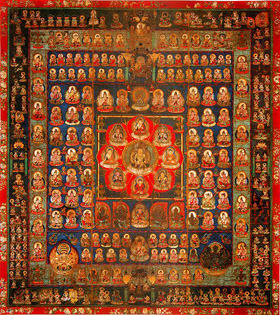
the mandala of the Maha Vairocana sutra
According to this tradition, when the Buddha had achieved enlightenment, he remained in the form of Vairocana for seven days during which he transmitted his teaching to Vajrapani and other bodhisattvas , an obviously symbolic transmission. However, it is the game of go that is at the center of the story, because the main character was a master in China in the 1940s, at the time of the Sino-Japanese War. Go competitions, likened to martial arts competitions, reflect the struggle between the two countries, but inverted: while the Japanese run from victory to victory, the go master remains invincible...
The three elements, esoteric Buddhism, martial arts and the game of go, are linked in the novel by
convergent symbols; Xu Haofeng seems to make them the three components of a “way” ( “道”) of salvation.
-https://www-chinese--shortstories-com.translate.goog/Auteurs_de_a_z_XuHaofeng.htm?_x_tr_sch=http&_x_tr_sl=fr&_x_tr_tl=en&_x_tr_hl=en&_x_tr_pto=sc
#xu haofeng#lost in translation#best overview of his writing i've come acorss so far#but still not what I was trying to find again
11 notes
·
View notes
Text
Yuri Romance Light Novel from the Creator of 'Adachi and Shimamura' Licensed in English

On Friday, Yen Press announced that it has licensed the Yuri drama light novel series My First Love's Kiss (Watashi no Hatsukoi Aite ga Kiss Shiteta) and will release the first volume in August 2024. The series is written by Adachi and Shimamura creator Hitoma Iruma and illustrated by popular Yuri artist Fly (Bottom-Tier Character Tomozaki).
The publisher describes the series:
Takasora Hoshi’s life is upended when a girl from her class named Umi Mizuike and her mother temporarily move into her family’s cramped apartment. From the outset of this arrangement, Takasora finds herself annoyed by Umi’s behavior...and her good looks. And though the two girls initially agree to avoid interfering with each other’s lives, Takasora can’t help but start to wonder where Umi keeps wandering off to at night…
My First Love's Kiss is connected to Iruma's high school Yuri series Adachi and Shimamura, with crossover characters appearing in later volumes. However, unlike that series, its story is more bittersweet and gloomy.

The light novels began publication in Japan in January of 2022 under ASCII Media Works's Dengeki Bunko imprint. The third and final Japanese volume was released in December of that year.
Hitoma Iruma is a Japanese author best known for his series Ground Control to Psychoeletric Girl and Adachi and Shimamura, both of which received anime and manga adaptations. He frequently collaborates with Bloom Into You creator Nio Nakatani, working with her on the Bloom Into You spin-off series, Regarding Saeki Sayaka, and the original light novel works End Blue and Shoujo Mousou Chuu.
Fly is an illustrator known especially for her Yuri artwork and for illustrating Bottom-Tier Characters Tomozaki and Chasing after Aoi Koshiba, as well as creating Kemono Friends and providing the character designs for P.A. Works' Iroduku: The World in Colors. Fly has also contributed artwork, cover illustrations, and manga for several anthologies, including four volumes of Syrup (Licensed by Seven Seas), the first Bloom Into You Anthology (Seven Seas), and éclair (Yen Press).
You can check out My First Love's Kiss when Yen Press releases the first volume in English this August.
Source: Press Release, Email Correspondence
109 notes
·
View notes
Note
I'm not sure if you have posted about this already. If you want to introduce Direngrey to new listeners, what are the first 5 songs you'd recommend? What about the first album? How do you describe their history/members briefly? Are there memes/common stories with the fandom like how k-pop or vkei go? Thank you!
Sorry for the very late reply. I was waiting to get some proper free time.
I would definitely go with the more recent tracks! It depends who the person is, what I know about their music tastes and whether they would tolerate screams at all. I don't have Unraveling handy enough unfortunately, so maybe instead, I'd go with other songs that illustrate how diverse their compositions are. Something like:
- The Final (which made me discover them)
- Ranunculus
- 13
- The Blossoming Beelzebub
- Kaishun?
First go-to album is always the most recent! No use getting them interested first in work that may not represent the band anymore or which they might never play again.
Hm I have never really had to describe the members, other than Kyo and his three bands and his cross-dressing tendencies. Some people aren't sure that the voices they hear (on sukekiyo especially) come from a man. As for the history, people don't seem to be interested in that as much as how long I've been following them, for some reason. But I imagine that I would relate the fact that they are embarrassed by their early looks and sound, that they became darker and more elaborate since, that they were kind of pioneers in touring overseas as far as Japanese bands are concerned, yet that in Japan, they are not mainstream at all.
Eh I'm not sure about memes, other than how they almost always answer: "Sou desu ne."/"That's right." in interviews hah? Otherwise, those screenshots of Die clutching his head after drinking wine were a highlight as well. But memes... Or you meant stories really about the fandom? Oh that was more problematic, there was some elitism, but I hope we can all respect one another and keep in mind that we don't listen to Dir en grey because our lives are rosy!
21 notes
·
View notes
Text
I found something very interesting. I was zooming in and out of Goemon's pictures when I suddenly translated his Bloodline magic which is given as "wind blade" in the English translation but when you trans"literate" the Japanese version you'll see it's "kamaitachi kaze" or "kamaitachi" wind. I felt like fainting for a moment because omg I've heard of such a demon from another manga, so I went ahead and did some research.
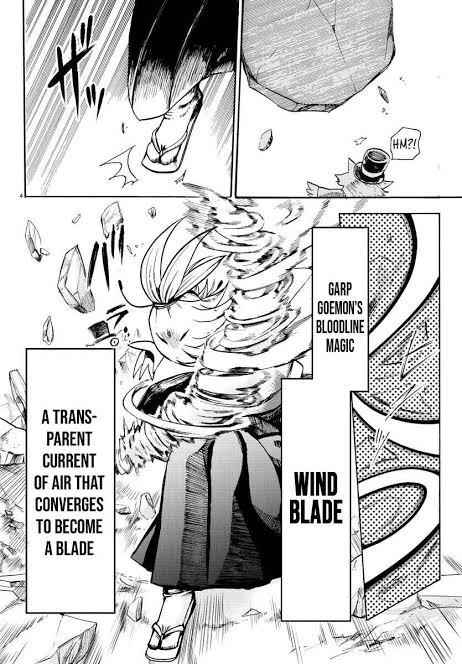
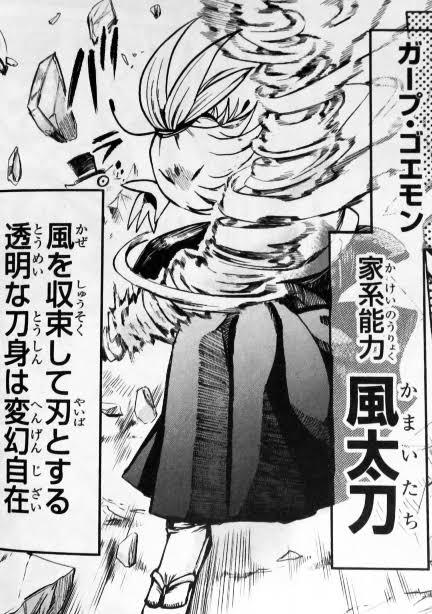
Kamaitachi is a weasel demon popular all over Japan. The legends about them vary regional wise. Originally, they referred to the strange happenings caused by wind and later the concept evolved to a weasel demon that has razor sharp claws like a sickle, that attacks people by enveloping them in a whirlwind, they don't even feel pain. Later on they experience pain and it can even kill them. They are said to travel on dust devils (whirlwind 🌪️) . This is the illustration of kamaitachi. It's so similar to Goemon's rescue gale! He envelopes the ones who he wants to protect and strikes the opponents.
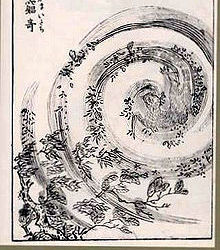

People call it a weasel for convenience. As you read on, you get more information. The true demon ofcourse is the wind itself that attacks in this whirlwind pattern. Its animal nature is described as,
"A beast with fur like that of a hedgehog, and a cry like that of a dog, and one that flies through the air with wings, they are said to attack people with limbs like that of a sickle or razor."
I also read that this demon doesn't attack samurais!
Goemon being a samurai demon, I wonder if that's a connection between him and the wind. Like, the kamaitachi and gaap clan has a contract between them and the wind aids them in battle. We can see Goemon asking the wind to help him during the harvest festival, like some heroes who pray to lightning or other such elements to give their power. I noticed that Goemon can summon the wind on the tip of his finger, without the sword.
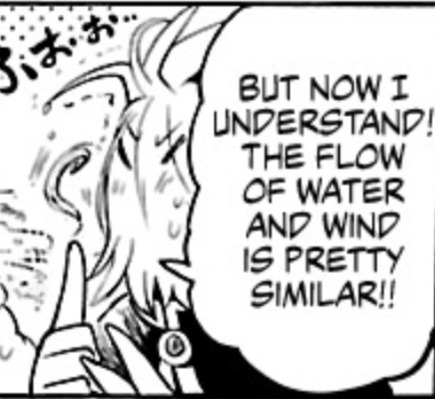
Another story says that when a woman jealous of her lover's new girlfriend cut her hair, the hair became the kamaitachi and slew the boyfriend. With this I'm happy that I discovered something that might be useful to know more about Goemon. We need to see more about him.
#welcome to demon school iruma kun#mairimashita! iruma kun#m!ik#mairuma#gap Goemon#gaap Goemon#garp Goemon#kamaitachi
106 notes
·
View notes
Text

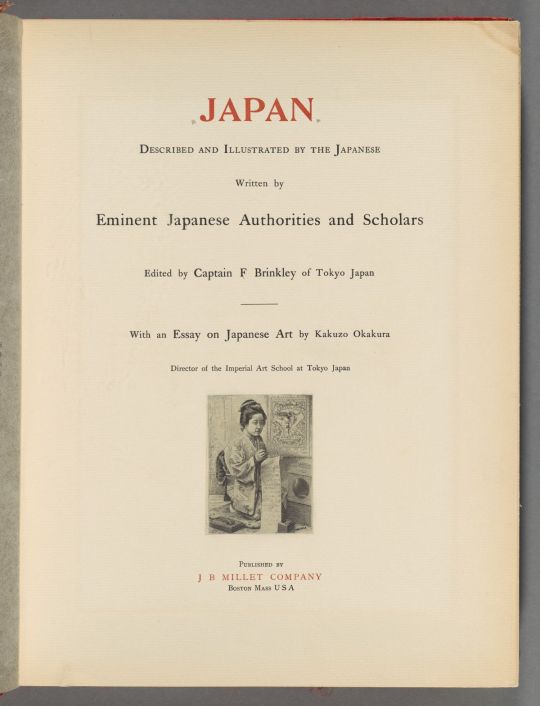

We’re back from a long break! Sorry for the long silence but we’re happy to be back again.
This summer, we launched a new website for Early Photography of Japan. It is a virtual collection of more than 40 souvenir photograph albums and illustrated publications from Japan with over 2,000 images from Widener Library, the Fine Arts Library, and Harvard-Yenching Library. In celebrating this new website, we’re posting several images from the Fine Arts Library’s collection.
Japan: Described and Illustrated by the Japanese – Part 1
In 1896, Tamamura Kozaburo, a highly successful commercial photographer in Yokohama, received an order from a Boston publisher that would eventually lead to the production of more than one million hand-colored albumen prints. At a time when most publishers were using illustrations produced via cheaper and faster photomechanical processes such as collotype or halftone, J. B. Millet Company used original photographs to illustrate no less than 16 different folio editions of the multi-volume Japan: Described and Illustrated by the Japanese published between 1897 and 1898. The publisher limited the most exclusive editions to 25 sets available by subscription only, along with larger editions numbering 750 to 1000 sets.
The key figures in this undertaking included a Boston publisher, an expatriate Irishman, and a Japanese photographer. Harvard graduate Josiah Byram Millet (1853-1938) founded his publishing company in 1890, and like many in the Boston area, he became interested in Japan, learning to speak the language and developing close connections to many Japanese statesmen, scholars, and businessmen. He conceived the idea for Japan: Described and Illustrated by the Japanese and used his connections to secure financial backing for the project from the Japanese government.
Stay tuned for our future posts!
From Japan: Described and Illustrated by the Japanese
Image 1: Front cover
Image 2: Title cover
Image 3: Page XI, showing Mt. Fuji
Description Brinkley, F. Japan :described and illustrated by the Japanese. Boston : J. B. Millet Company, 1897-1898. Imperial edition. Fine Arts Library, Harvard University.
Repository Fine Arts Library
Institution Harvard University
#Earlyphotography#EarlyphotographyofJapan#japan#Japanesetouristsphotography#handcoloredphotographs#YokohamaShashin#横浜写真#写真#handcoloredphotography#Japanese#HarvardFineArtsLibrary#Fineartslibrary#Widnerlibrary#yenchinglibrary#Specialcollections#Harvard#HarvardLibrary#harvardfineartslibrary#fineartslibrary#harvard#harvard library#harvardfineartslib#harvardlibrary#photography#special collections
83 notes
·
View notes
Text
A correction on Karasuma’s career
(...And Takaoka’s too I guess)
A fandom wiki can be a fickle thing. Sometimes helpful. Sometimes, straight up misinformation.
Some time ago, I woke up in the middle of the night, pondering something about a character’s past that I immediately needed to check- as one is bound to do when they should be asleep. Said character? Karasuma Tadaomi of Assassination Classroom (as some mutuals will have cleverly guessed from the title).
...Except. Something was wrong. I’m not talking about his description as a ‘handsome young man’, because it’s supposed to be true within canon (despite visual evidence to the contrary). I’m talking about facts that are harder to disprove just by a glance- especially since the source isn’t written.
“I’m... pretty sure Karasuma never was in the Air Force, that doesn’t sounds right.”
“Warrant Officer? ‘According to the manga, Karasuma’s dress during his career-’ where. Which panel is it and where can I compare it to an actual uniform.”
“Uh, Takaoka’s profile doesn’t help much more. ‘Takaoka and Karasuma were in the same squad in the military but were in different sections.’ That’s not possible, as a squad is part of a section. And unsourced too.”
So. Even though I don’t participate in the fandom. I had to do something. Edit the wiki? Well I don’t know if I need permission to do that, so no. But, there’s something much easier I can do, one thing I’m pretty used to.
Complain about it on Tumblr!
So, I looked up what I could. The official French translation, the English scans. His Graduation Album’s profile just in case, though it was unhelpful. Hunted down his tankobon’s profile, and, bingo, a career path! ...With a few differences from the French translation. Hmm. At this point I would need to look at the raws.
Thankfully, I do have Roll Book Time, in paper format, a gift of years ago from my good friend and sweetheart. Unfortunately, I don’t actually read Japanese- but as if that stopped me in the past! By now I’m an expert at painfully looking over radicals to search for accurate kanji on jisho.org, one at a time. It’s long and tedious and in the end I still rely on Google Translate, but at least I’m going somewhere.
So, without further ado! Let me show you what I’ve got!
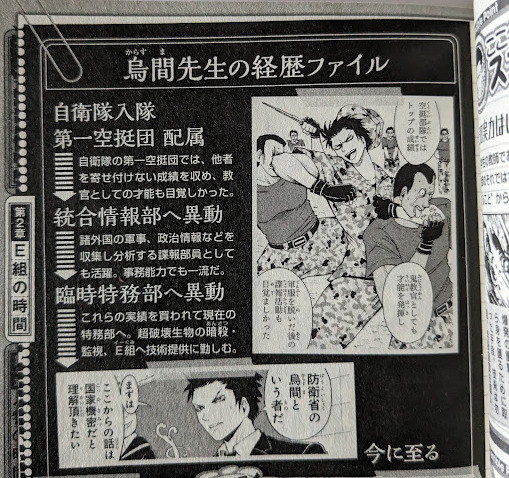
[Alt: Photo of a half page from the Roll Book, describing Karasuma’s career. The text is in Japanese, and illustrated by two panels from the manga. One shows Karasuma in camo uniform training recruits, the other shows him at the start of the manga, presenting himself to the 3-E. ]
For those of you who wants to read the Japanese text, but it is too small or the pic isn’t showing, here the transcription:
烏間先生の経歴ファイル
自衛隊入隊
第一空挺団 配属
自衛隊の第一空挺団では、他者を寄せ付けない成績を収め、教官としての才能も目覚しかった。
統合情報部ヘ異動
諸外国の軍事、政治情情報などを収集し分析する諜報部員としても活躍。事務能力でも一流だ。
臨時特務部ヘ異動
これらの実績を買われて現在の特務部ヘ。迢破壊生物の暗殺・監視、E組ヘ技術提供に勤しむ。
As for some sort of translation, here’s a little something to get the gist of it, but don’t consider this as a totally accurate translation.
Karasuma-sensei’s background file
Enrolled in the Self-defence Forces
Assigned to the 1st Airborne Brigade
In the SDF’s 1st Airborne Brigade, his talent was unmatched. His talent as an instructor was also remarkable.
Transferred to the Defense Intelligence Office
He had been active as an intelligence agent who collects and analyses military and political information in other countries. His office ability is also top notch.
Temporary transferred to the Special Services Office
Due to his past results, he was brought into the Special Affairs Department. He works with the monitoring / assassination of the “destructive creature”, and teaches his technique to Class E.
So, the first point of this.
The Japanese Self-defence Force (which I will abbreviate in JSDF) is, like most if not all armies, divided into ground, air and naval forces.
You would think the 1st Airborne Brigade is part of the Japan Air SDF, since there’s ‘airborne’ in the name. And you would be wrong! It is part of the Japan Ground SDF, and my, what a part it is. They’re considered among the toughest soldiers of the JGSDF, deserving of their “The Matchless Elite Second To None” motto. While the JSDF are supposedly defensive, as the name said, for legal reasons (they technically can’t call themselves an army because Japan can’t have one), this brigade is considered as one of the few with an offensive capability. Yeah, fitting for Karasuma!
(And yes, this means Takaoka has been part of it too. Which... kinda explains why he underestimated Nagisa so much. If you’ve been in an elite troop for years, you can let a scrawny teenager with a knife get closer to you a few steps further, just to prove a point.)
Then, we have what the tankobon profile’s translator chooses to translate as “Information Bureau”, but I choose Defense Intelligence Office.
You see, the original text was 情報部. Now, Matsui has been known to slightly modify the name of actual places/schools rather than reference the actual thing (dunno if he’s required to do it or it’s a personal choice). And, if you take 部 (office, bureau, department- I prefer ‘office’ since it’s found in the translation for some Ministry of Defense’s extraordinary organs) and add 本 to make 本部 (headquarters), you get 情報本部, which is the Japanese name of the Defense Intelligence Headquarters! Which is still part of the Ministry of Defense, so it makes sense the transfer could be done.
(As for Takaoka- The first page of chapter 38 shows us a shadowed Takaoka, with his chief going ‘It’s a hidden ball trick, courtesy of our Information Bureau’. So I guess it’s either a natural advancement career, either he followed Karasuma there, or this guy has the worst of luck.)
Finally- Special Services Office- or Division, as per the English scans. But the tankobon profile translation talks about ‘Special Forces’? Well, I can disprove that.
The Special Forces Group of JGSDF is 特殊作戦群 in Japanese. Meanwhile, 特務部 is... nowhere close from that, except there’s 特(special) in their names. Furthermore, we do have an 部 again at the end, which implies an office/department/division/etc. Given the explanation in Karasuma’s profile, I would assume this office was created specifically to deal with Korosensei, and various agents were transferred to it temporarily? Notably, Karasuma and Takaoka.
--
Now, that solves it for the Air Force misunderstanding. What about Karasuma’s rank, though?The fandom wiki mentions his uniform in the manga. Which turns out to be one panel. It... makes sense, since Karasuma is no longer part of the JSDF, having transferred, and so wouldn’t be able to use a military uniform on important events ; the French translation of Karasuma’s chief’s words in his flashback from chapter 38 even says “After you abandoned your military uniform [...]”. What is this famous panel, then?
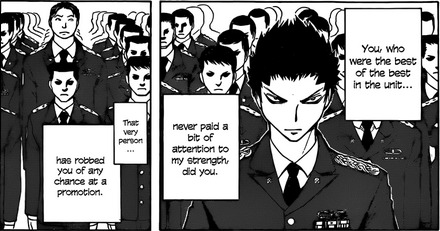
...Well, that’s going to be tricky. We don’t have a view of the arms themselves, though he doesn’t seem to have a patch. Then we have the notch lapel insignia, but those meant for rank are put on the upper notch- the lower notch is for the branch of service, from what I gathered in photos. (And I mean, it would be ridiculous as a rank insignia- it seems to have three dots in a triangle, so either a captain or a colonel, can you imagine this, a colonel? A guy in mid-twenties? Ridiculous)
What about the shoulders, then? Well. Let me tell you a thing.
...Finding things about Japanese formal dress military uniforms is super annoying. US uniforms? Sure, no problem. French uniforms? If you type in French, sure. Japanese Uniforms? Oh, did you mean WWII Imperial Army uniform? No? You’re sure? Because this is what you will get. Oh, sure, Wikipedia has a page on the ranks and insignia of the JSDF. But it doesn’t seem to account for those formal epaulets, which are only used in ceremonies.
But! There’s a silver lining! Typing 陸自 儀礼肩章 (JGSDF formal epaulets) in a pic search, we can then click on the ones that interest us and look for the grade. (Though, some of them seem to come from Yahoo Auction, and are unavailable to me). So, on our manga panel, we have three dots on the knot, plus a little one at the end to pin it to the uniform.
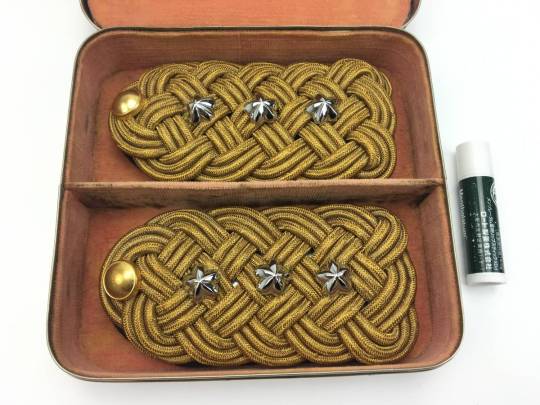
Something like this. Now those specific ceremonial shoulder insignia are for a 一等陸佐 (or 1等陸佐), which correspond in the US Army to... uh. Hm. Wait. Let me check. Gotta be a mistake. He can’t be a colonel.

...A bit smaller but that will do. Notice how the knots have one less... wire? Thread? Look, I’ve put way too much energy into this post to start worrying about words. Anyway, the number of stars might be the same, but the whole epaulet is different. And we even have the less formal insignias on the side! Those are for a 1等陸尉, which corresponds to... Captain.
...No, seriously.
I mean, you can check on other sources if you want. Wikimedia even has this photo if you don’t believe me.)
As for Takaoka (as well as every man present in the panel), it’s small but you can see two stars on his shoulders, so he has the grade just below- 2等陸尉, which corresponds to first lieutenant. But hey, maybe Matsui and his assistants took a random uniform as reference! You know, the anime tends to have interesting background details in the classroom, so maybe they would also have been careful with this!

...Ah, yeah, not really. What about Takaoka?
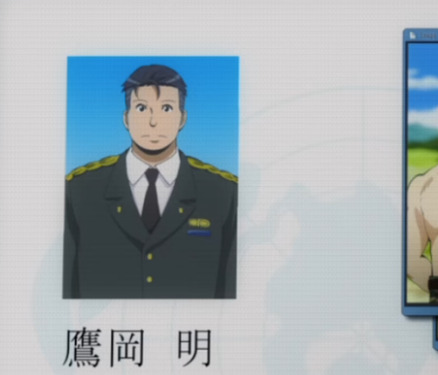
...Well. Not very helpful either. It does show us he has the service ribbon for the Medal with Blue Ribbon, a Japanese medal of honour awarded to individuals who have made significant achievements in the areas of public welfare or public service. As for the weird infinity sign- this pin badge is likely the same as Karasuma’s in the manga, which is not quite clear on the scan, but I can confirm on the tankobon that it’s the Ranger Courses pin badge. The fact it is golden means he specifically completed the Fuji School one, which is needed to be a course instructor or an officer.
...So, I have no idea where this Warrant Officer rank came from. It would make more sense, but it seems like somehow, Karasuma reached captain rank. Despite being in his mid-twenties (he’s 28 by the time of the manga, which is to say, after he spent time at the Defense Intelligence Office). Seriously, is it too much to ask for a bit of realism in my supersonic giant yellow octopus manga?
...One mystery remains, though.
...Where the hell did Karasuma find the time to get a valid teaching license? Because he does tell Gakuhô he has one early on, and being an instructor for military recruits certainly doesn’t require the same license as to teach middle-schoolers. Did he get a special rush training between the time Korosensei said he would be 3-E’s teacher and whenever chapter 3 happens? Or did he just happen to have one before? He probably entered the JSDF as soon as he got the minimum age, so I can’t see how. Matsui please show us your notes.
#assassination classroom#ansatsu kyoushitsu#assclass#karasuma tadaomi#takaoka akira#long post#...this was originally going to be way longer as I narrate my struggles in searching for information#but I keep pushing back this post because it would take so long to write so. Guess y'all got lucky
23 notes
·
View notes